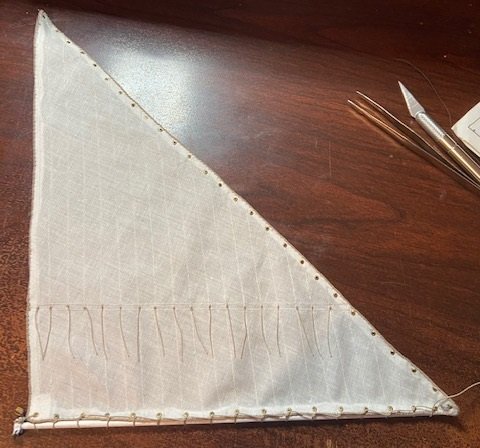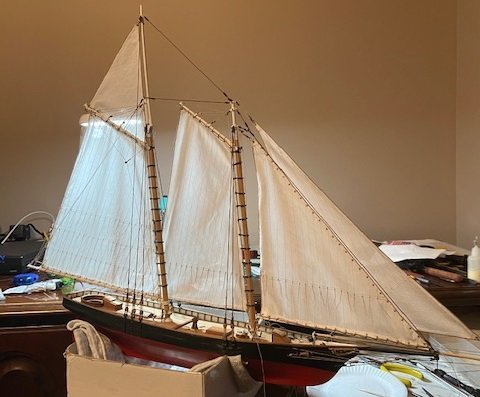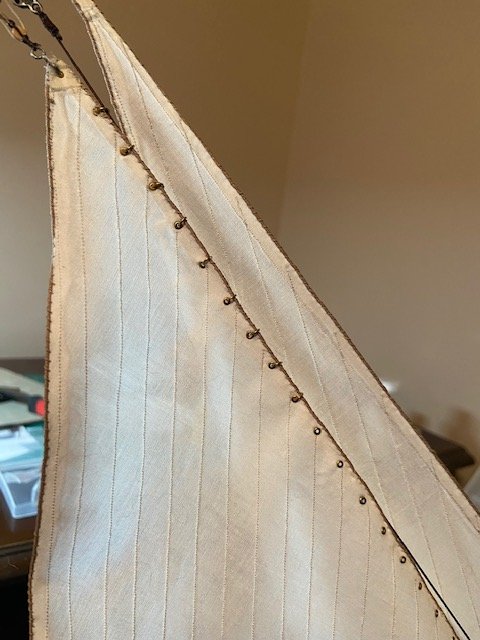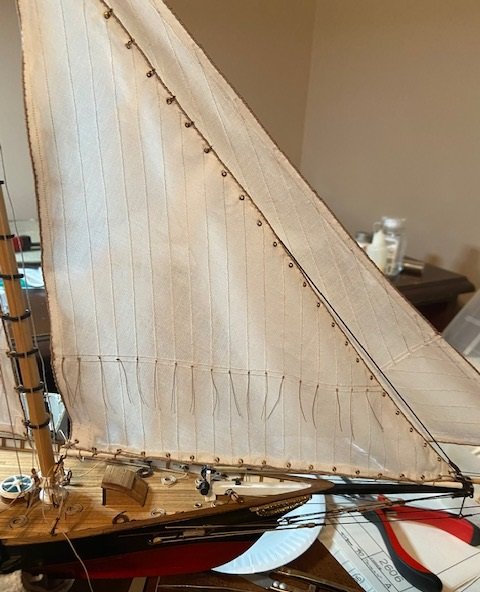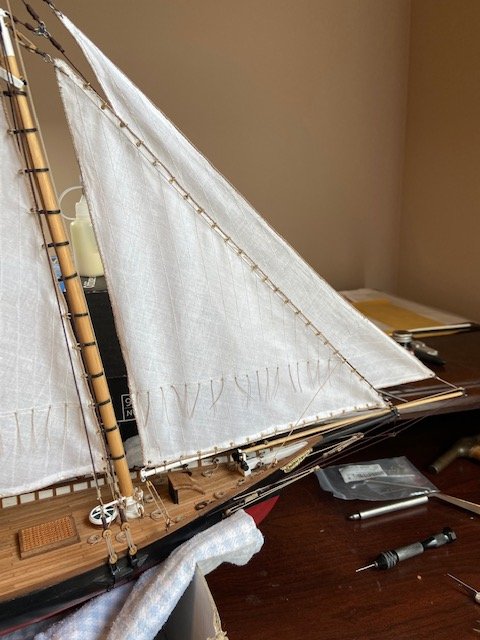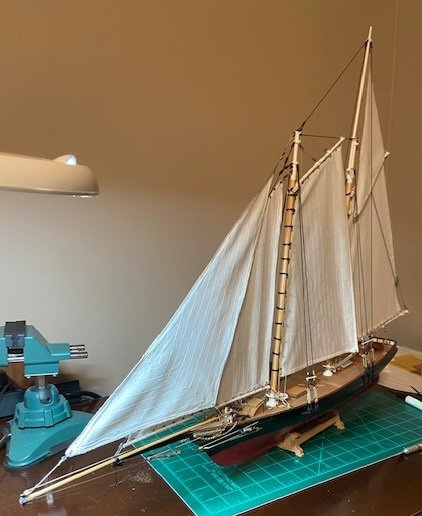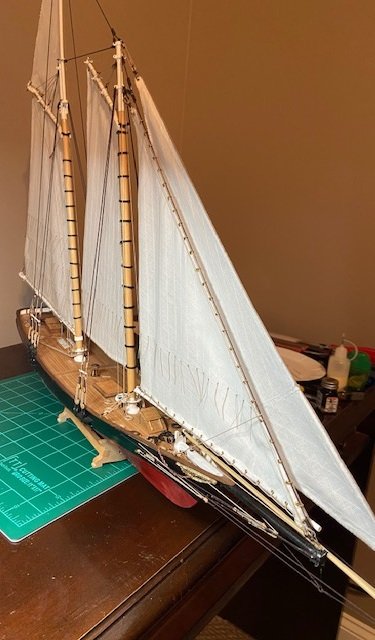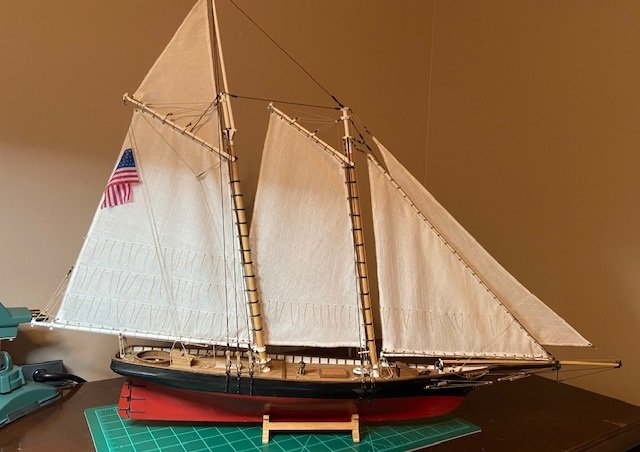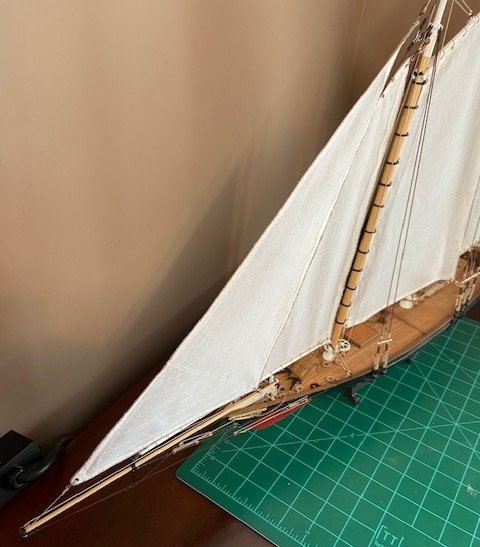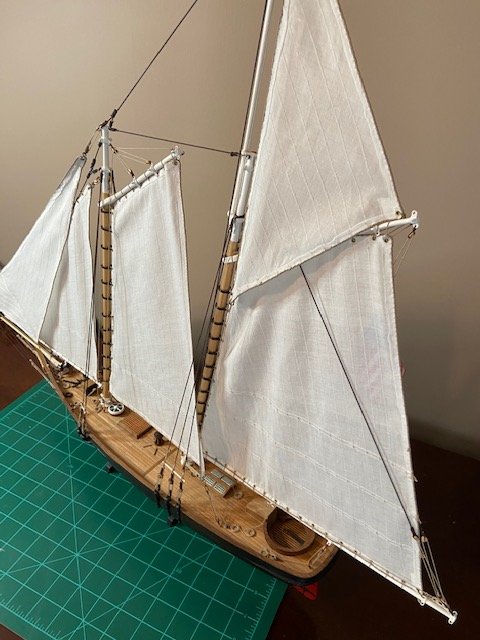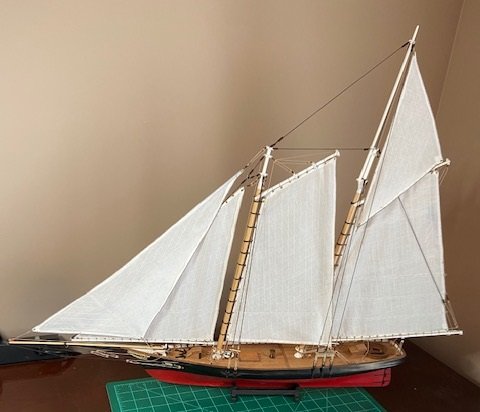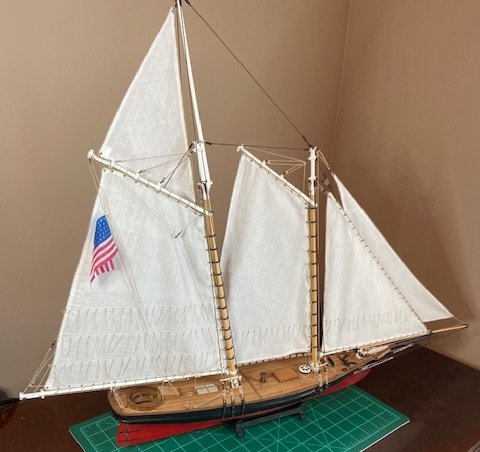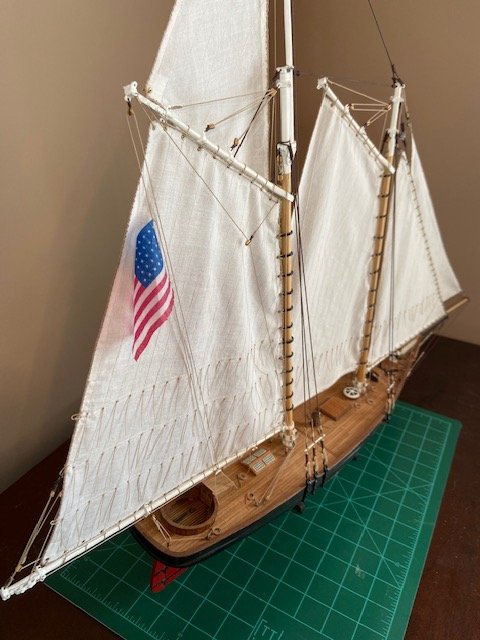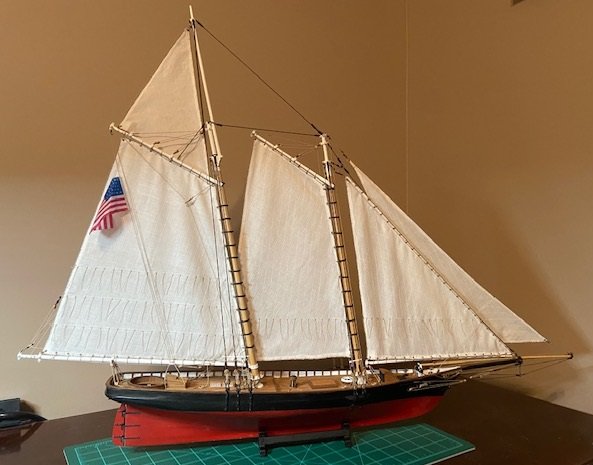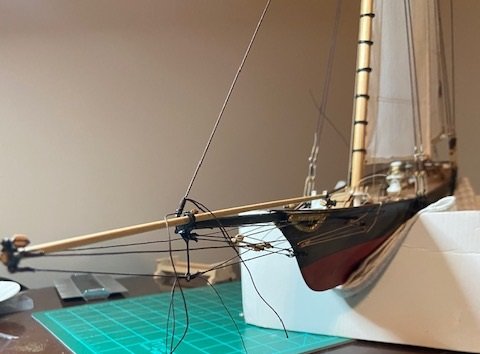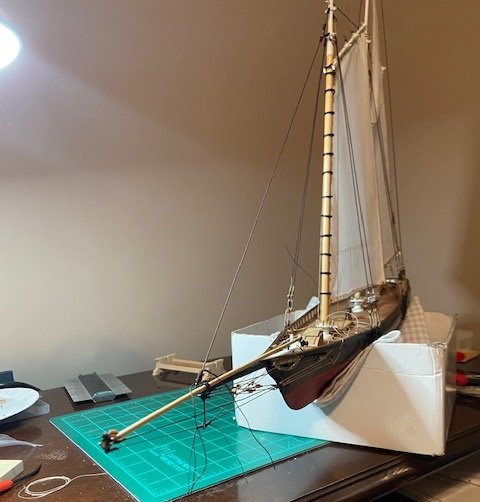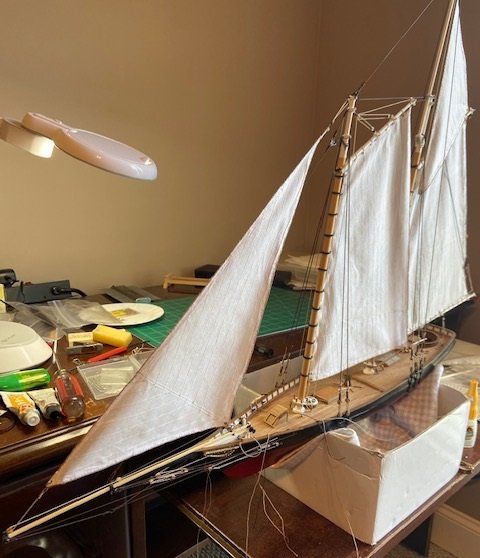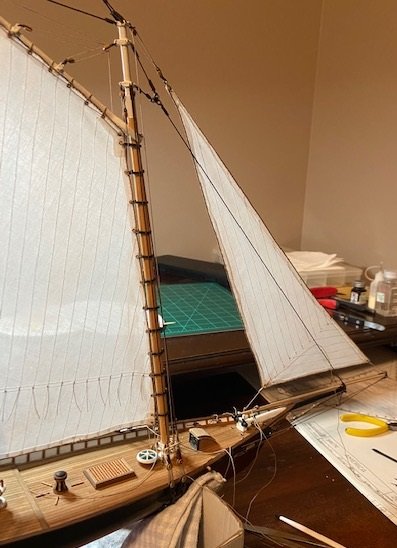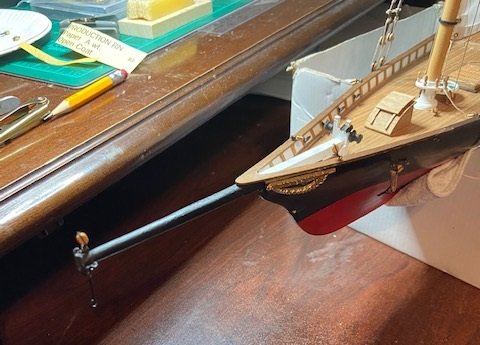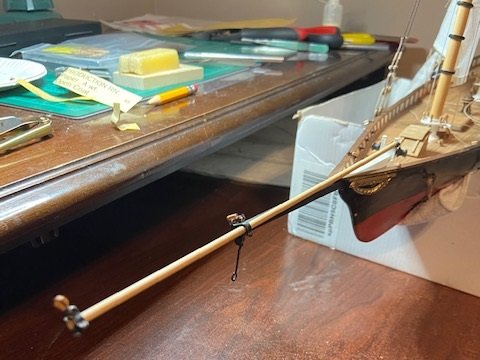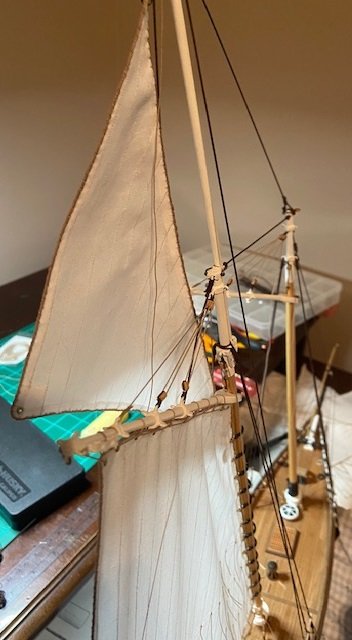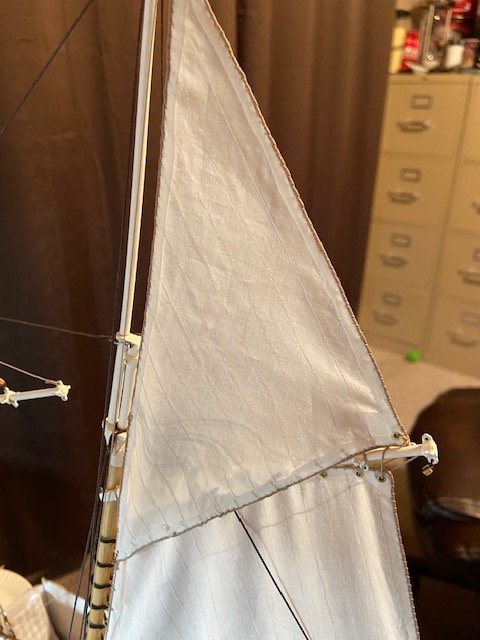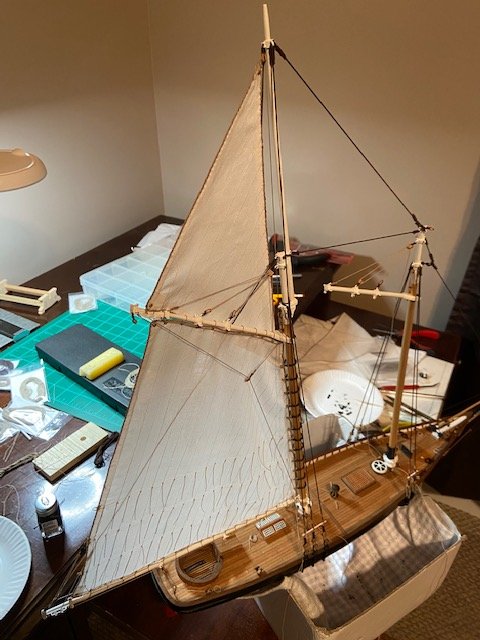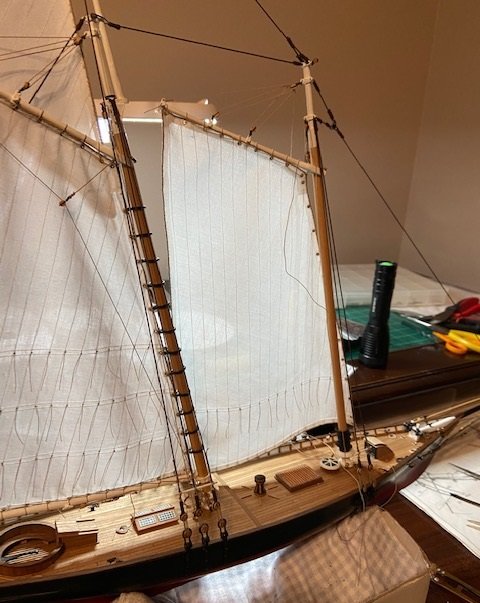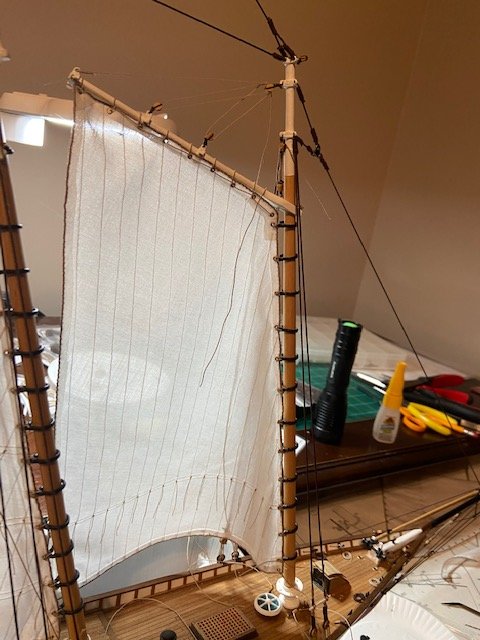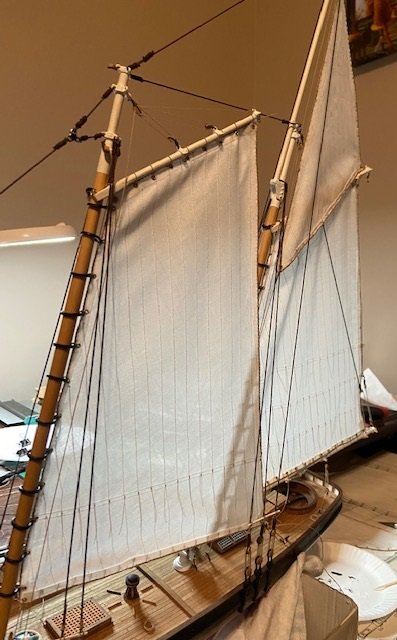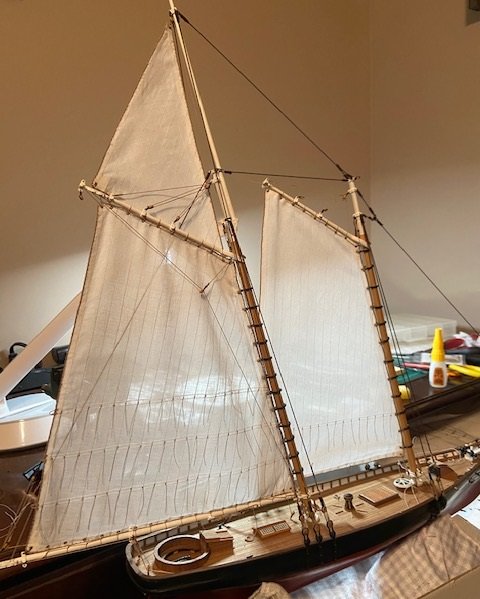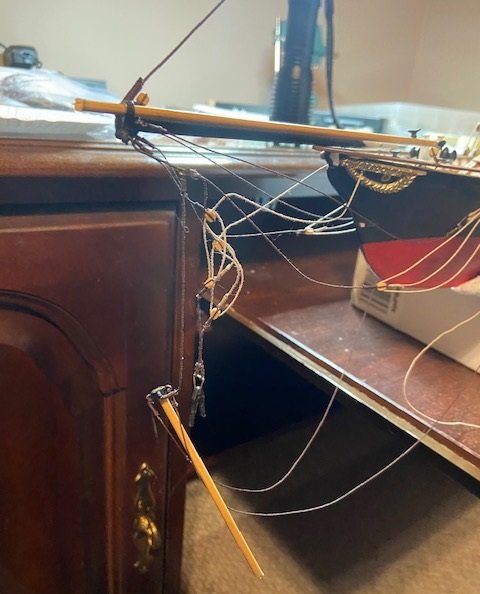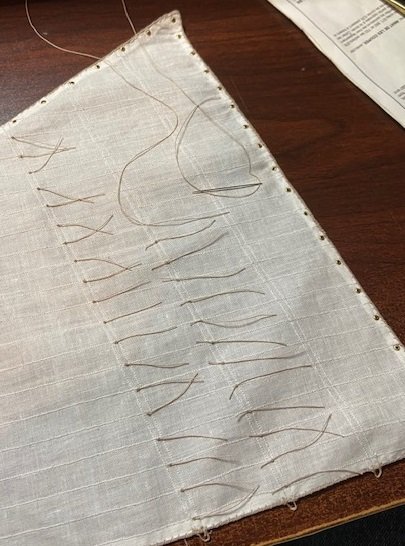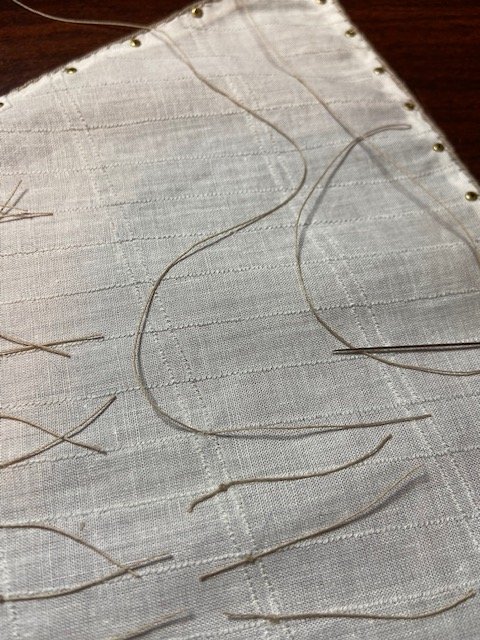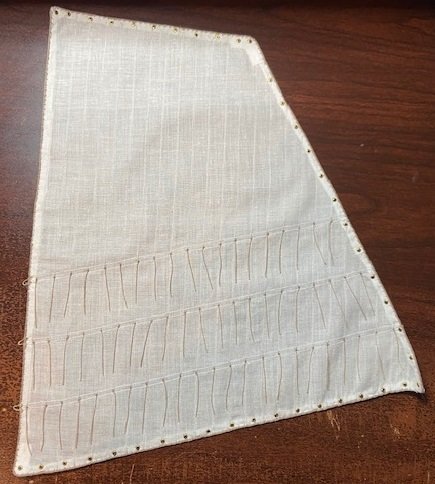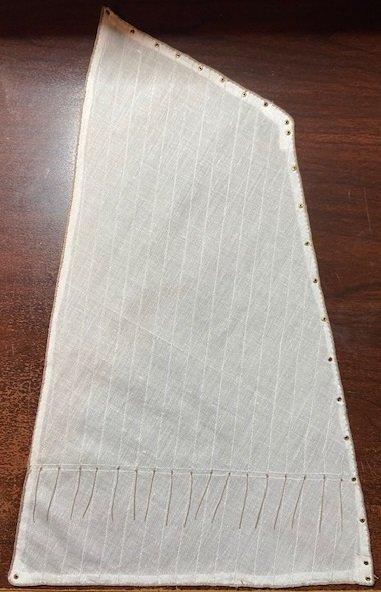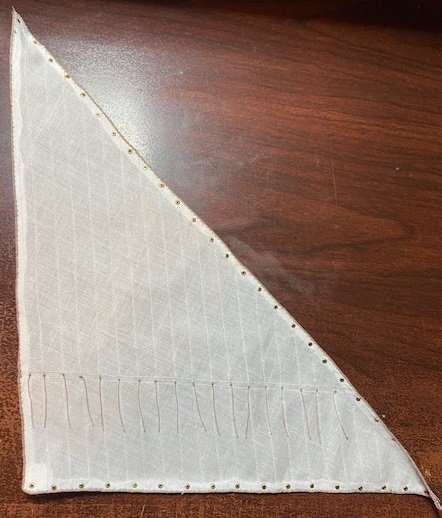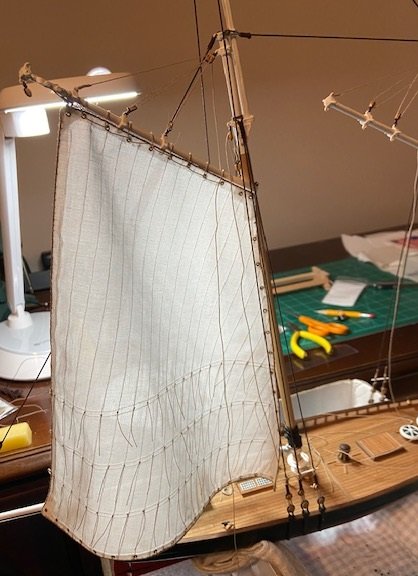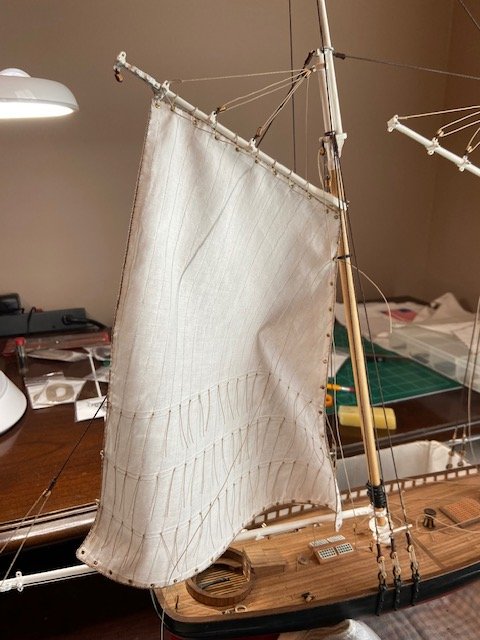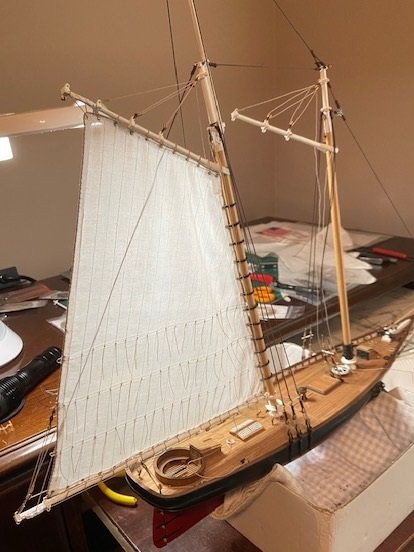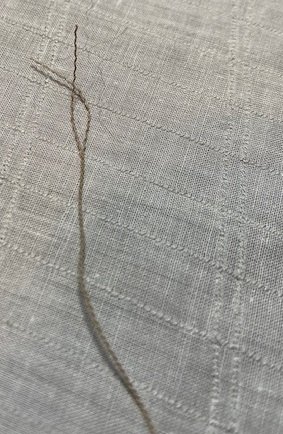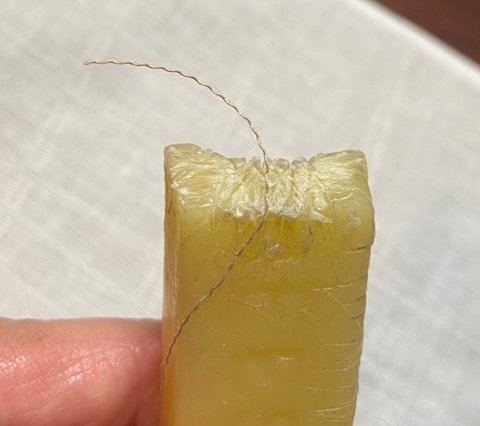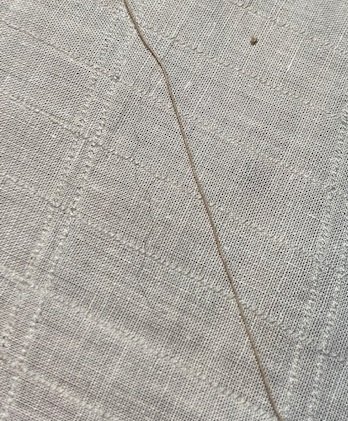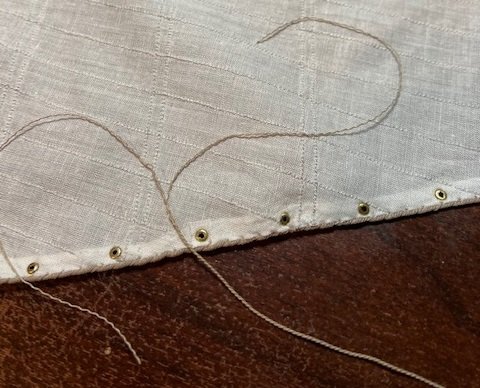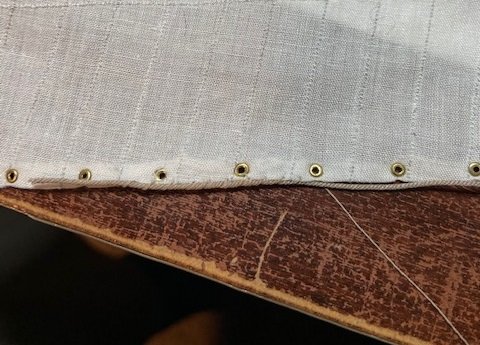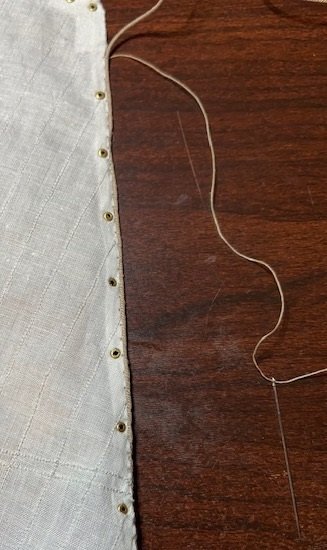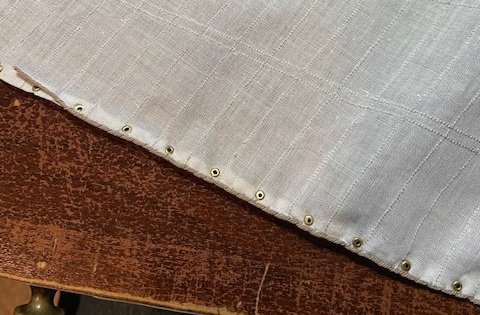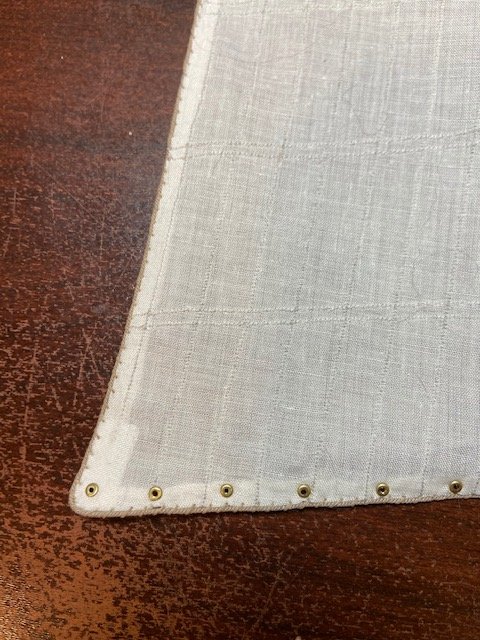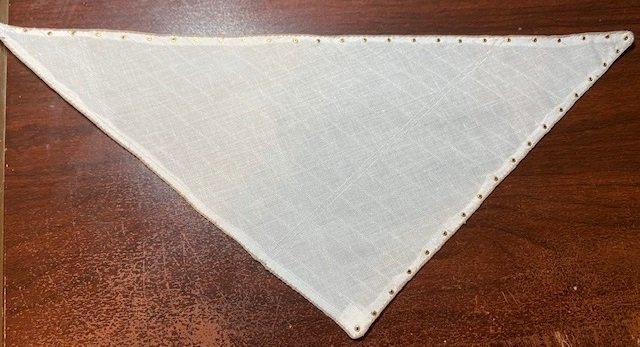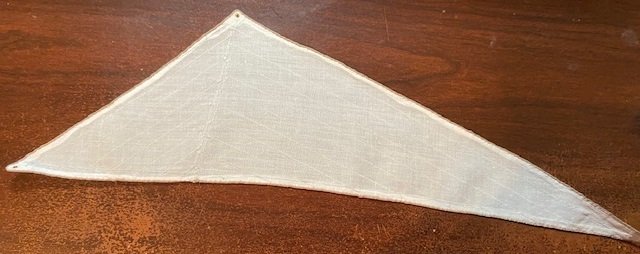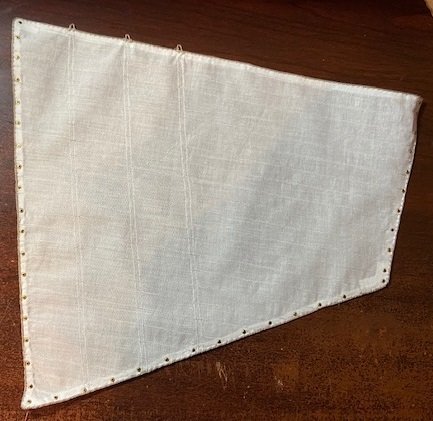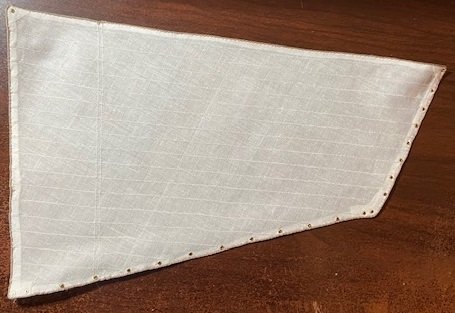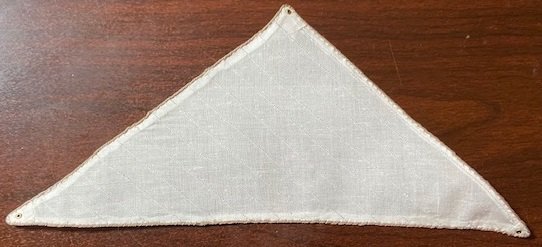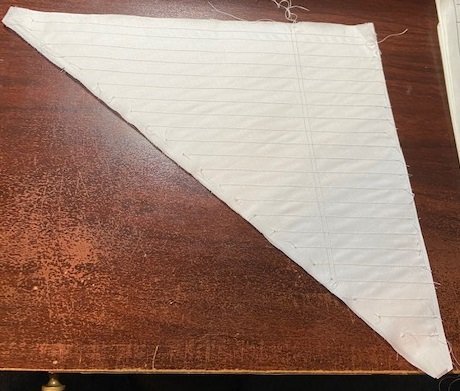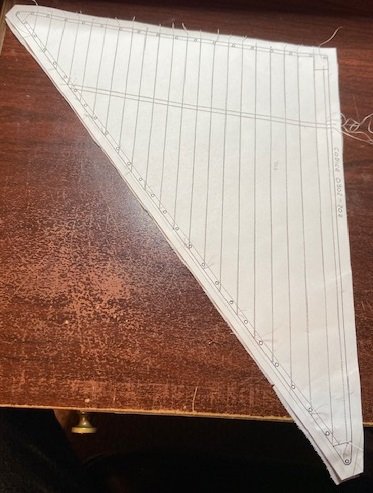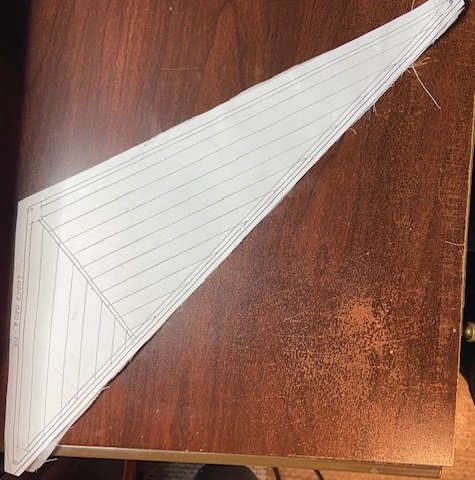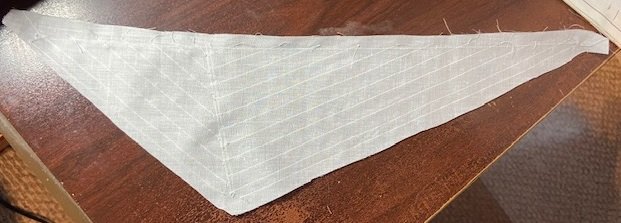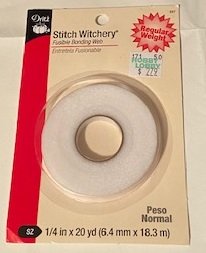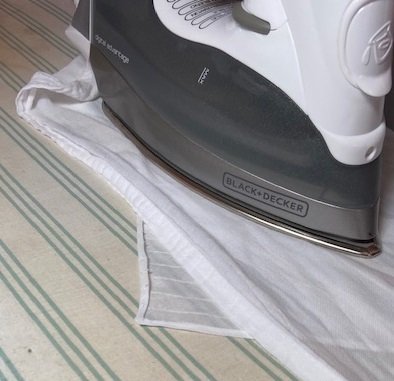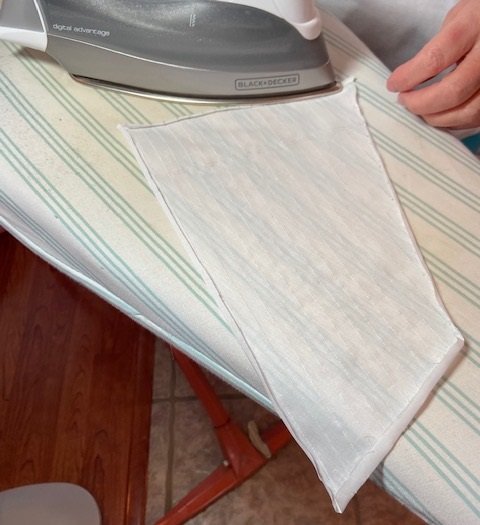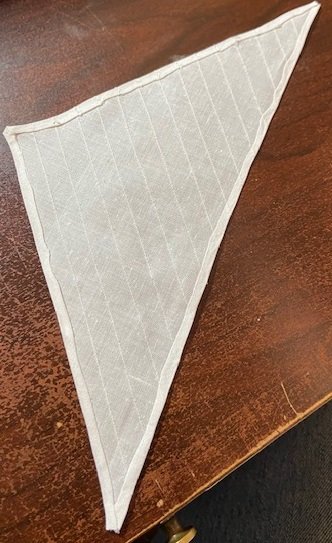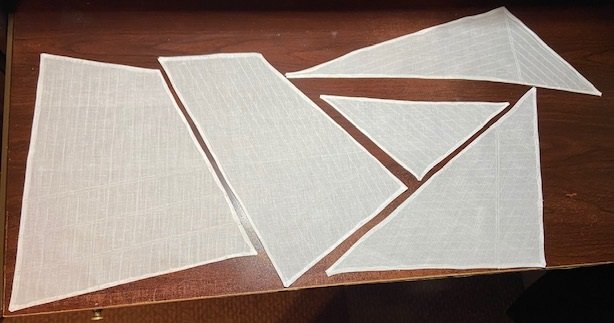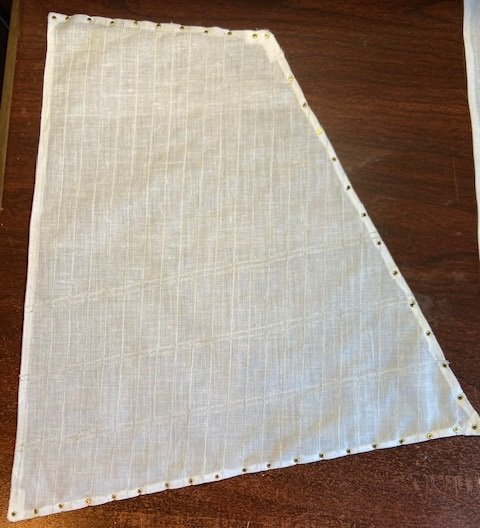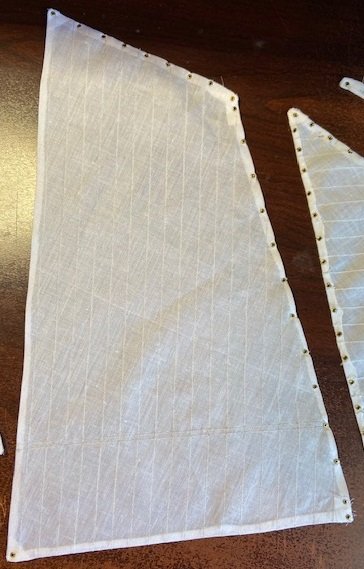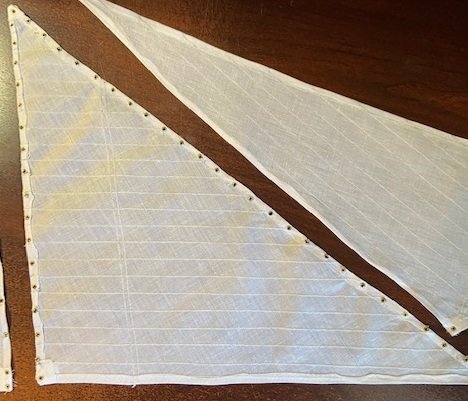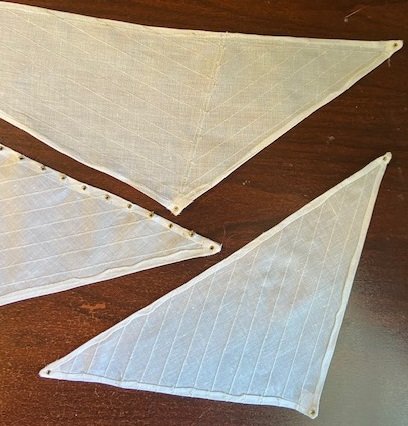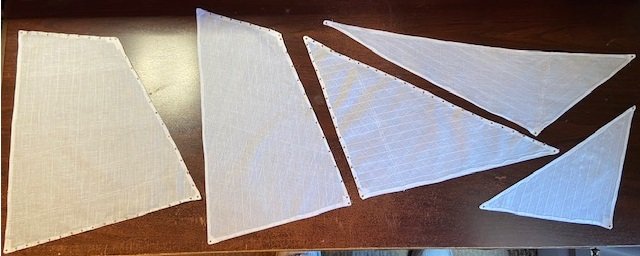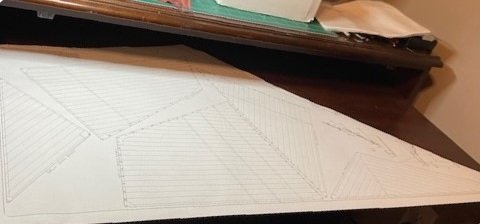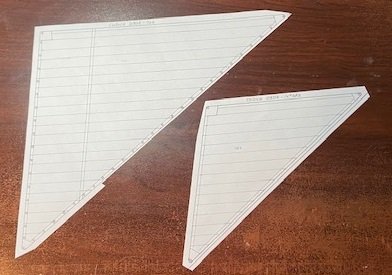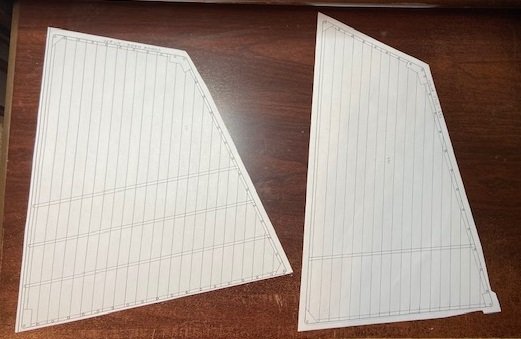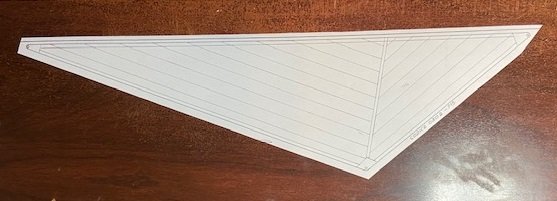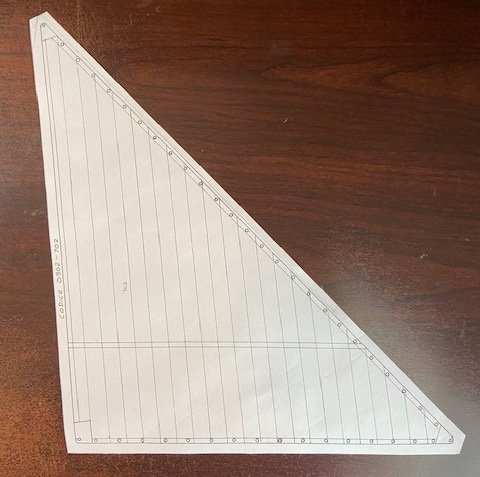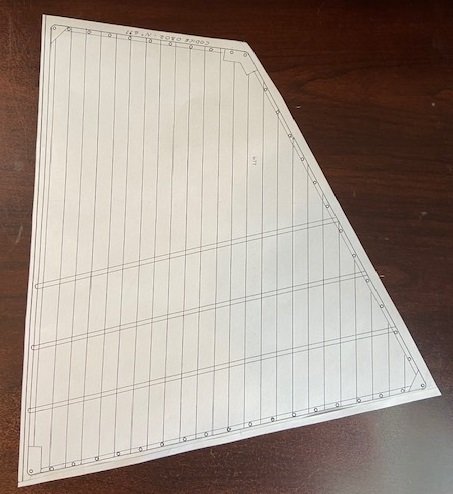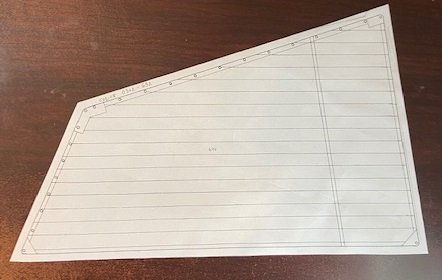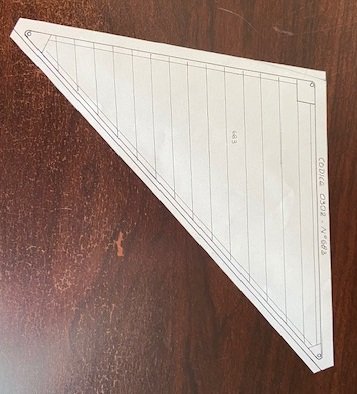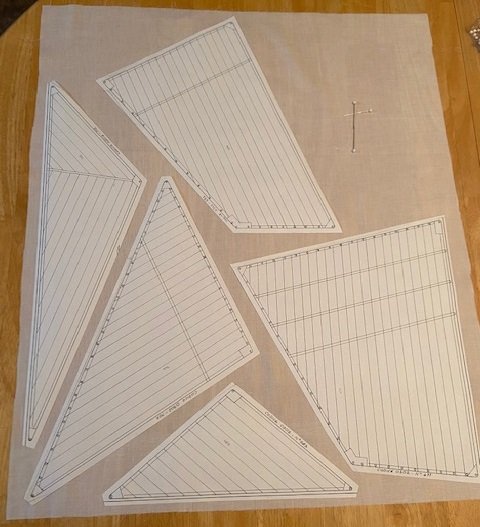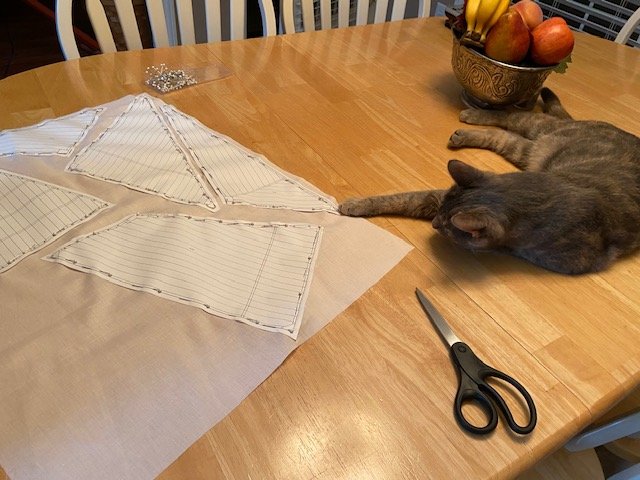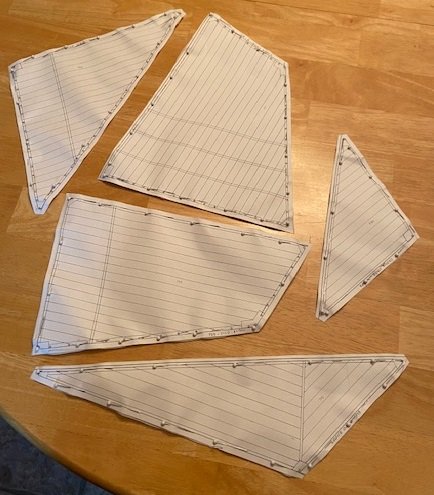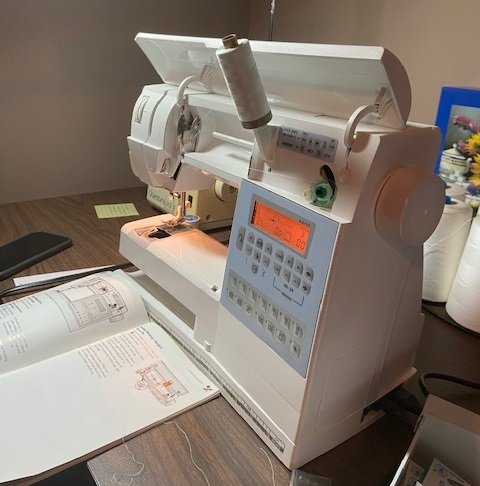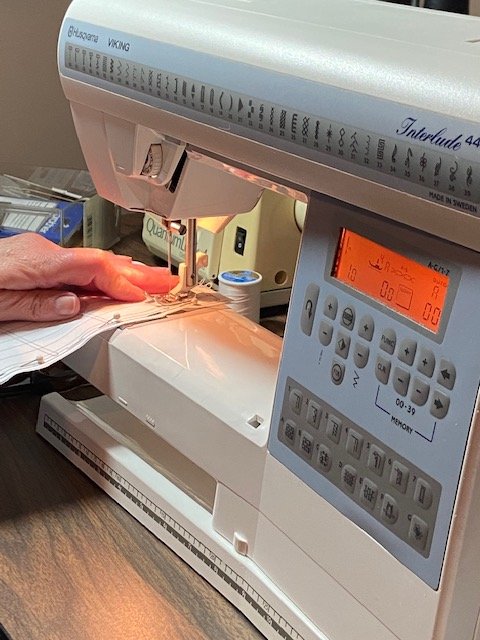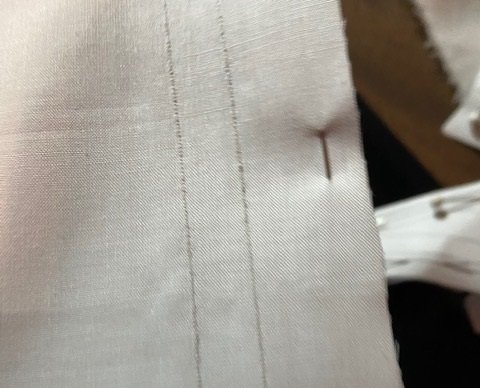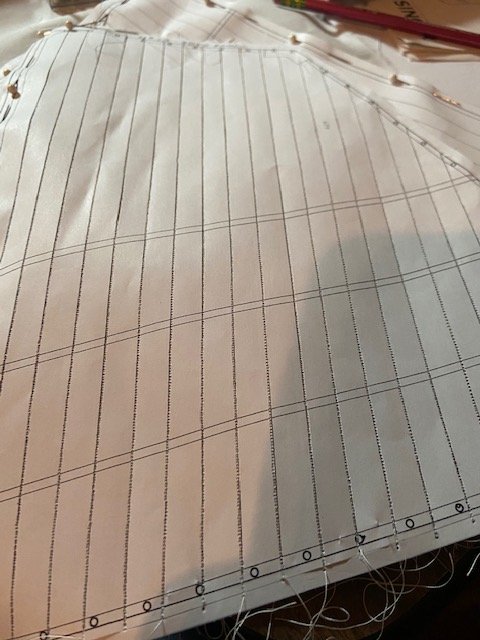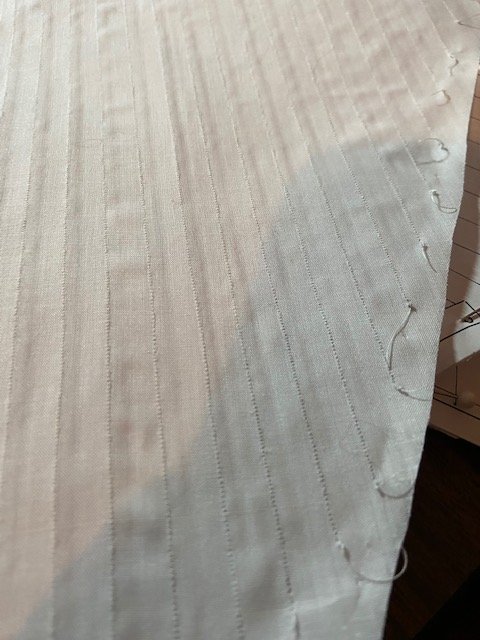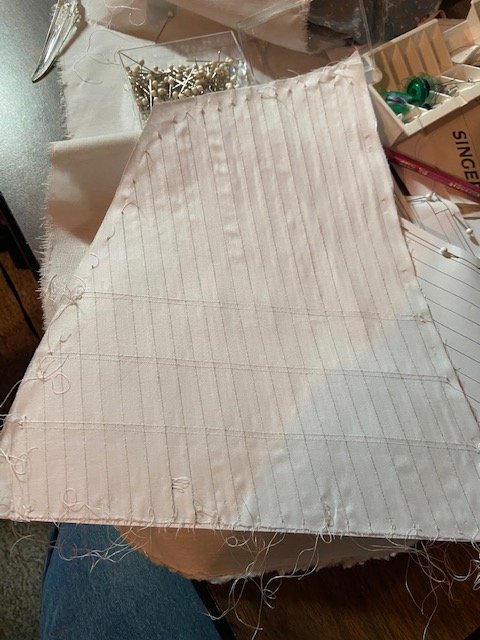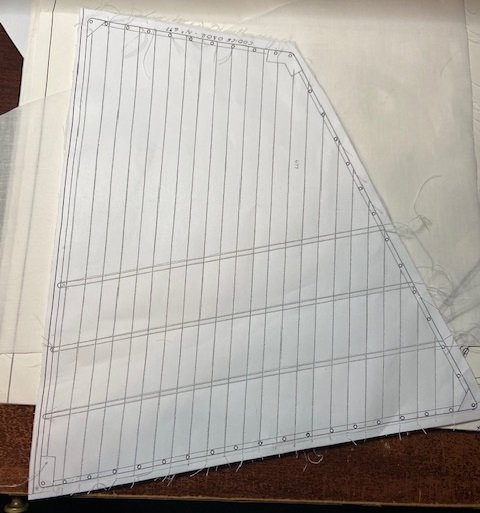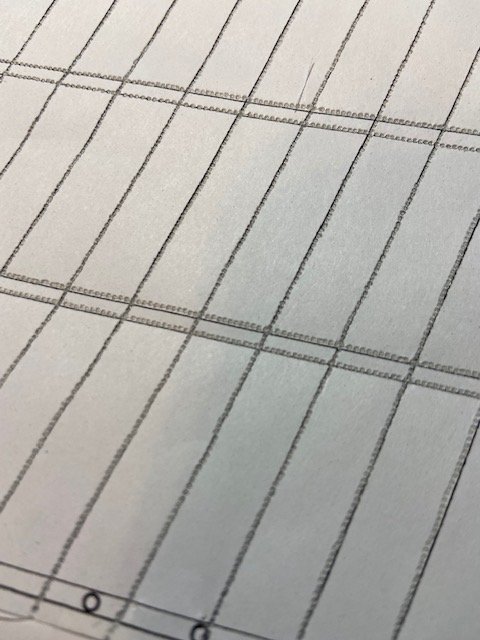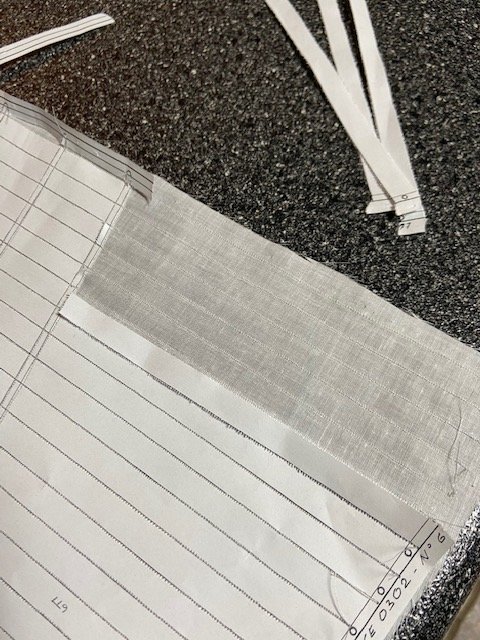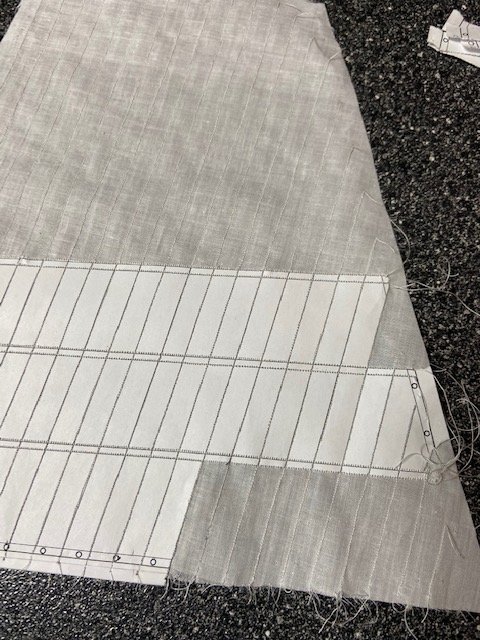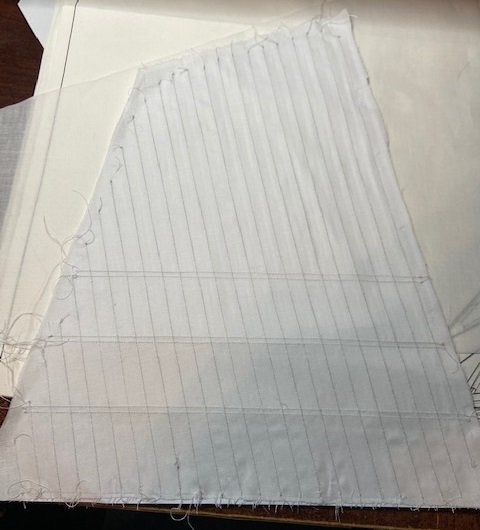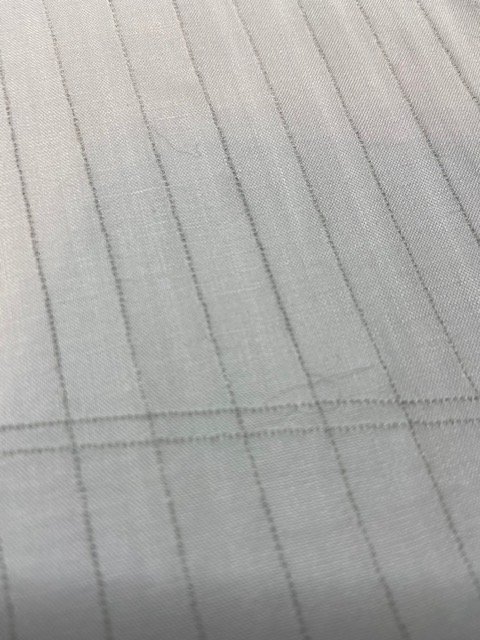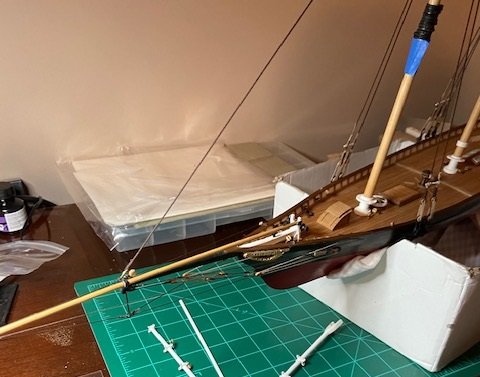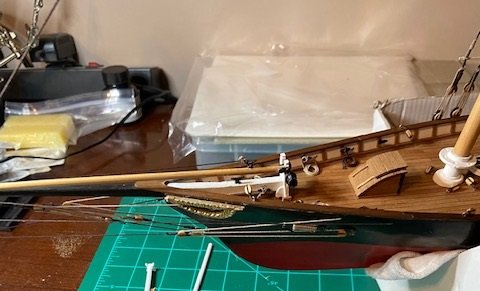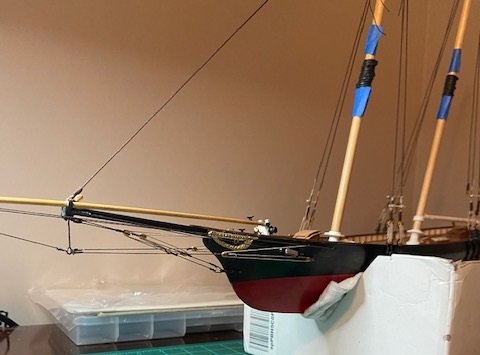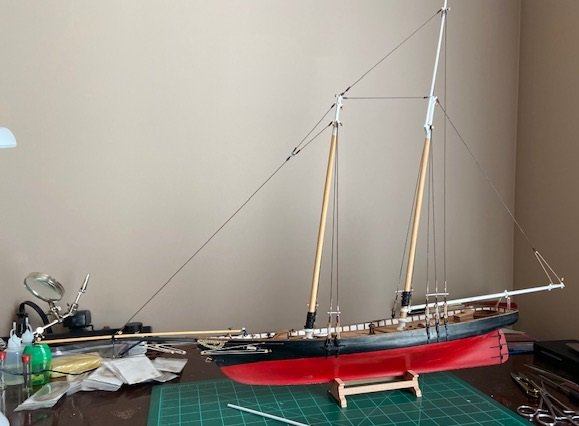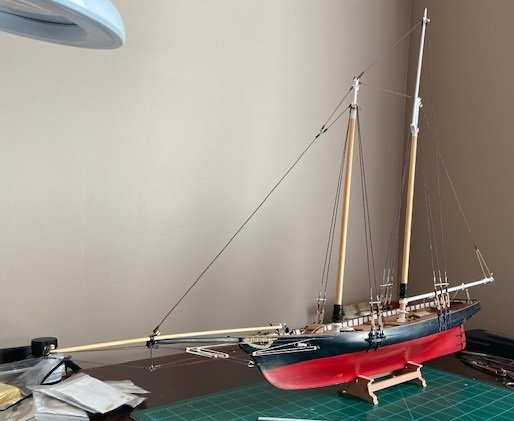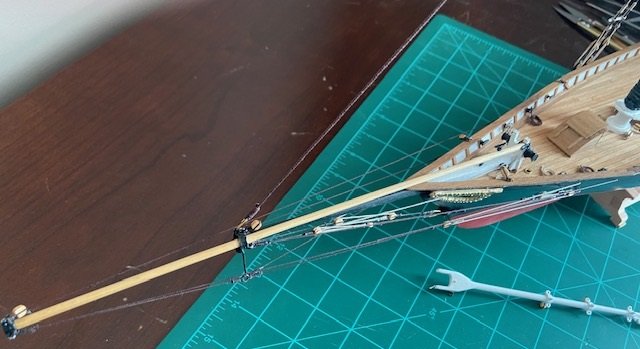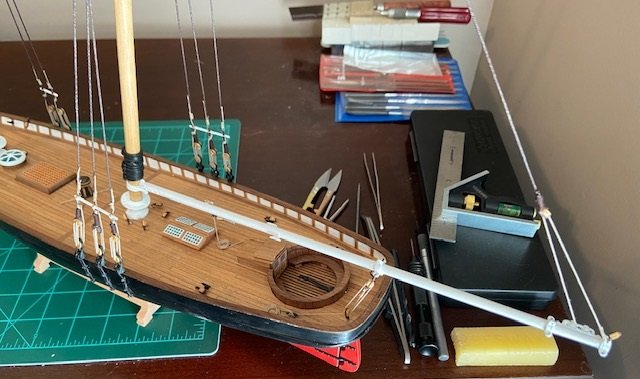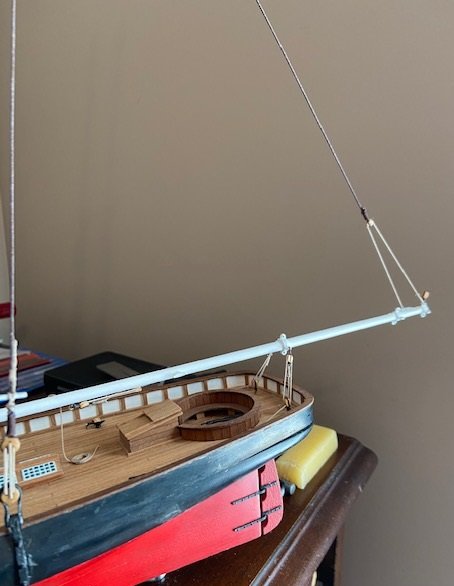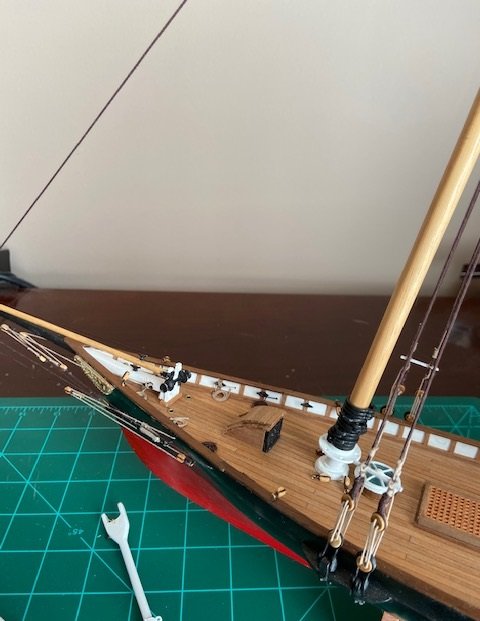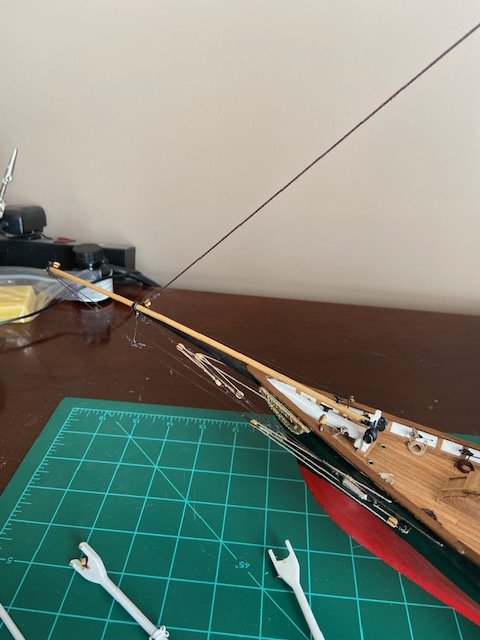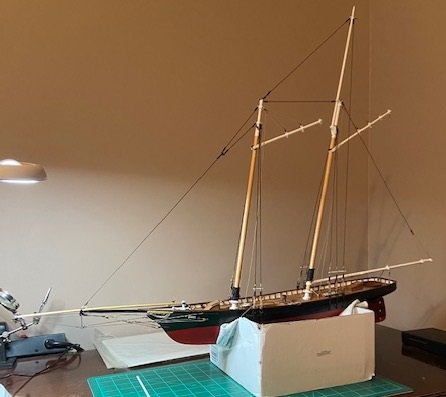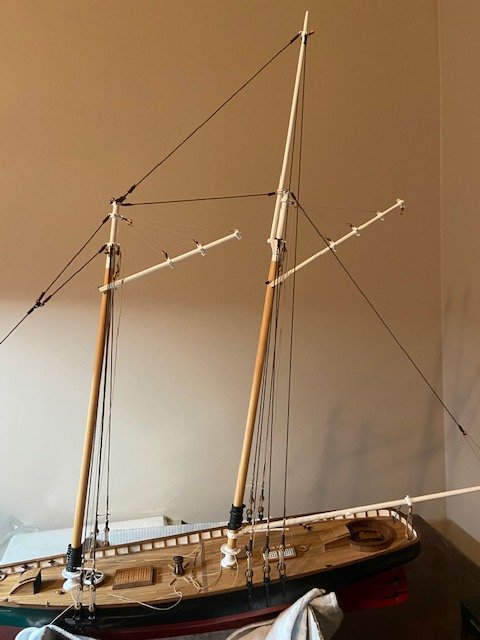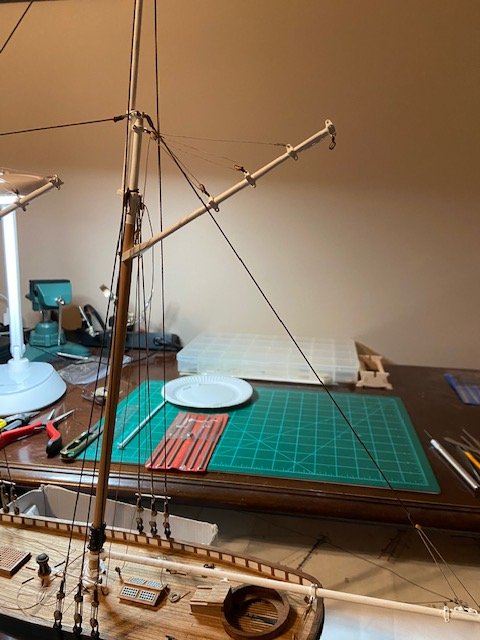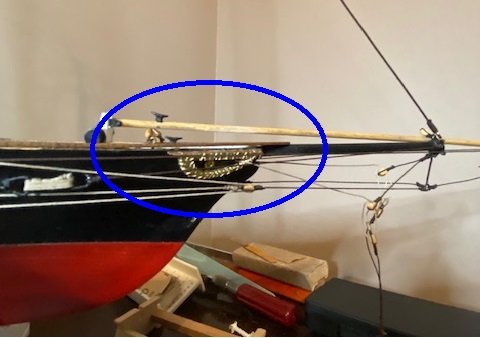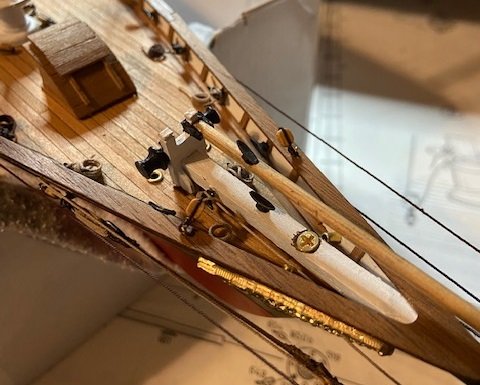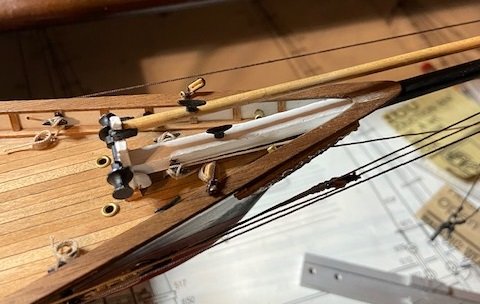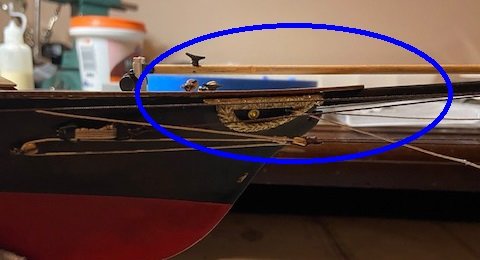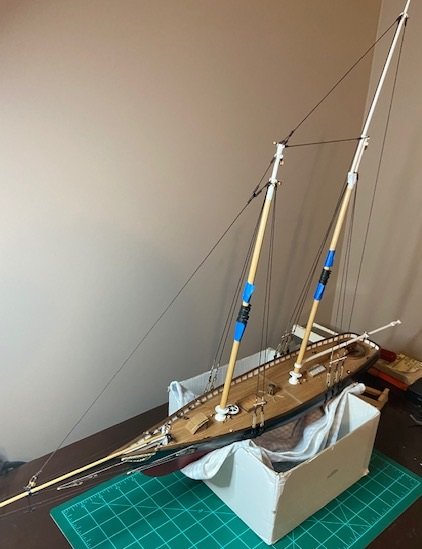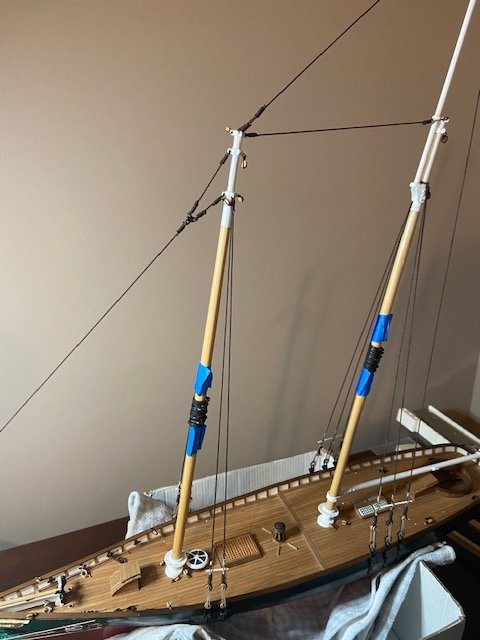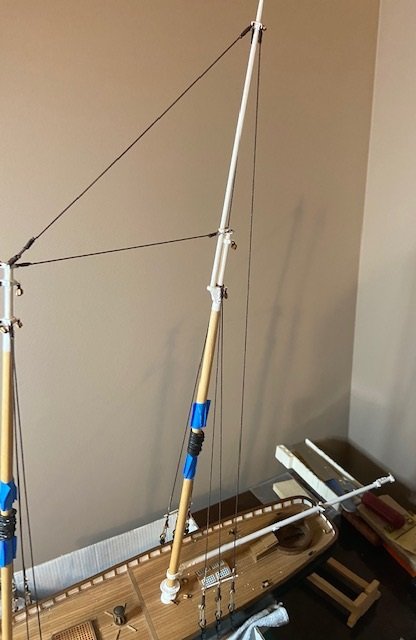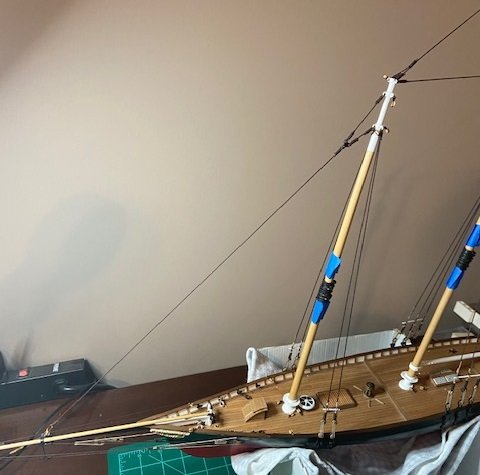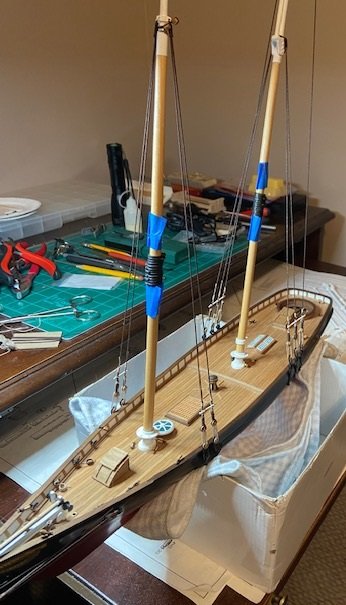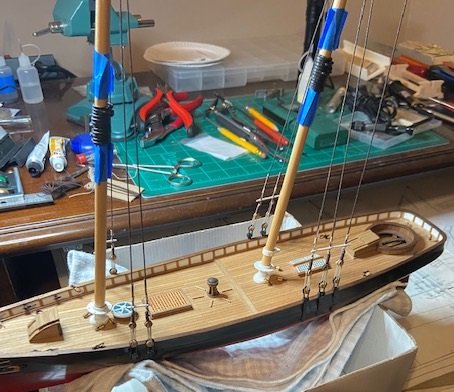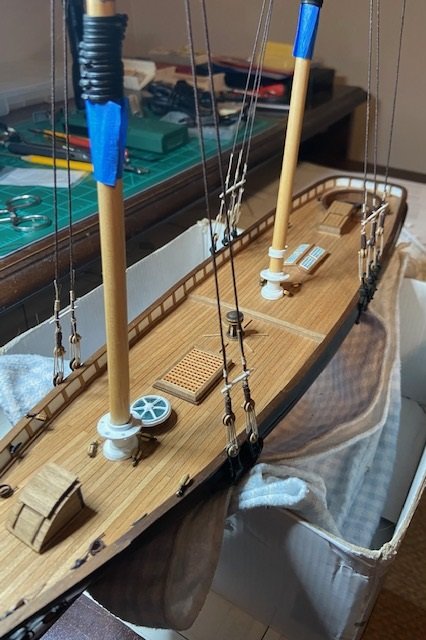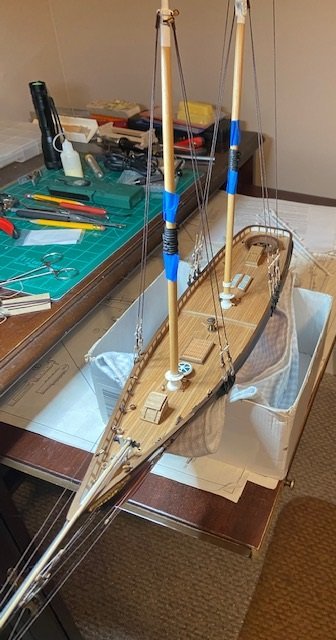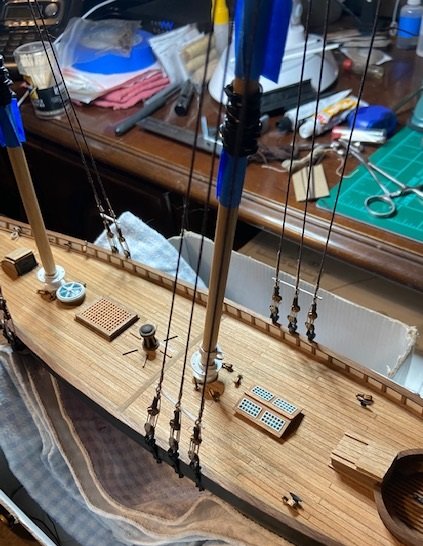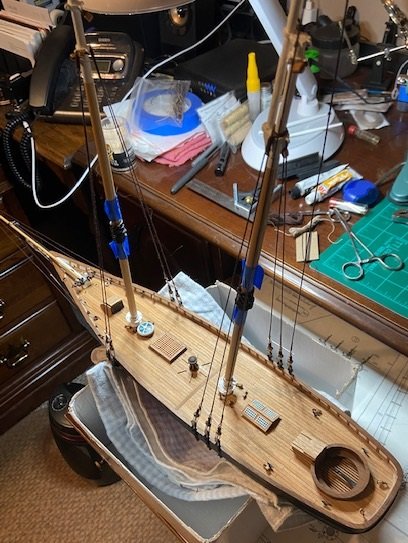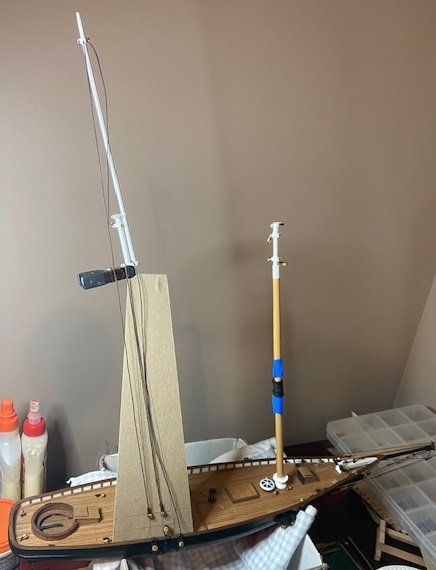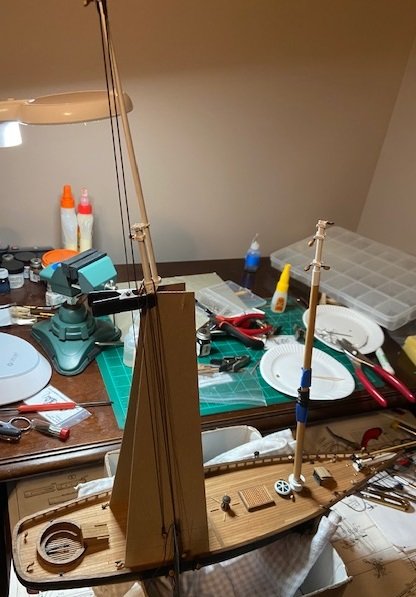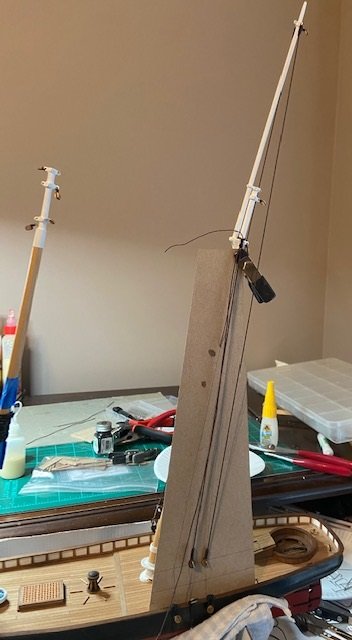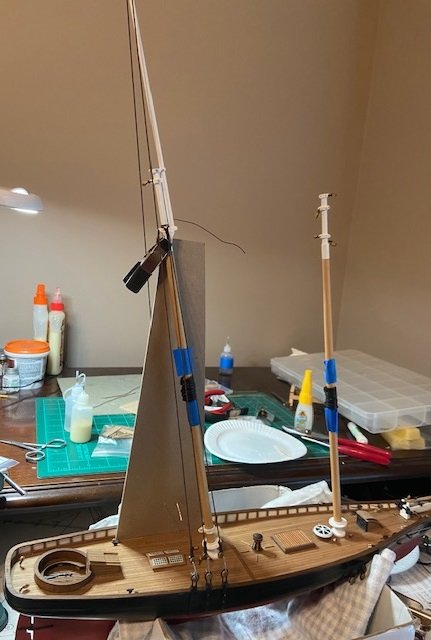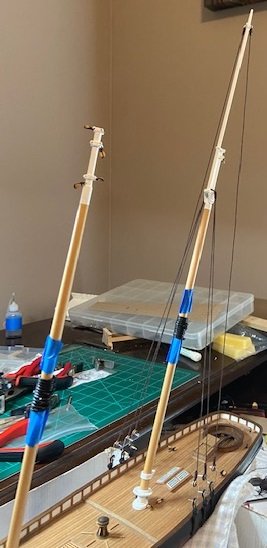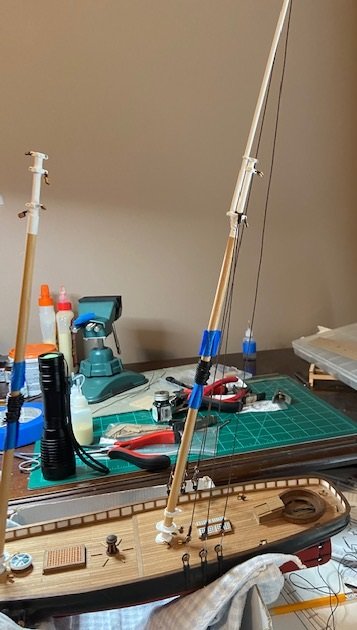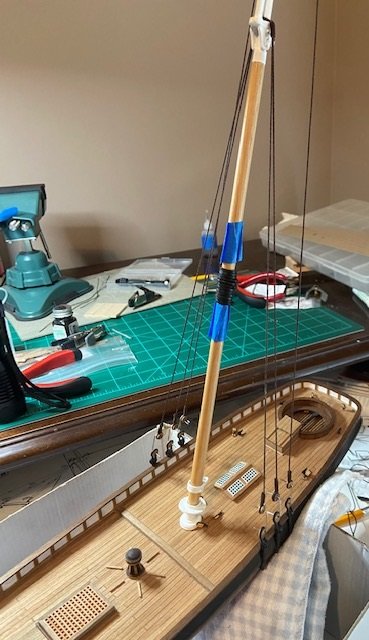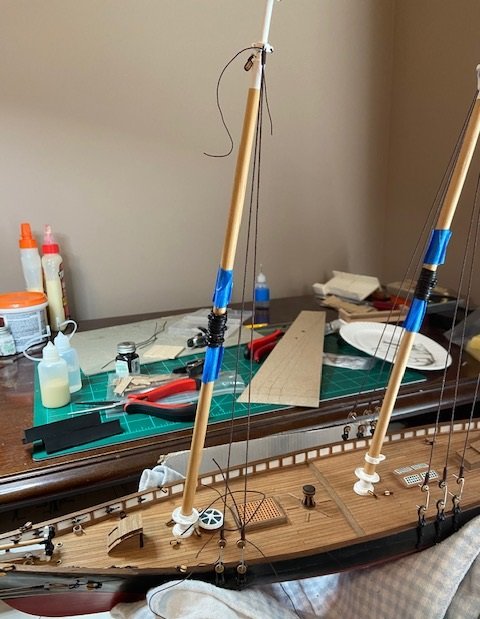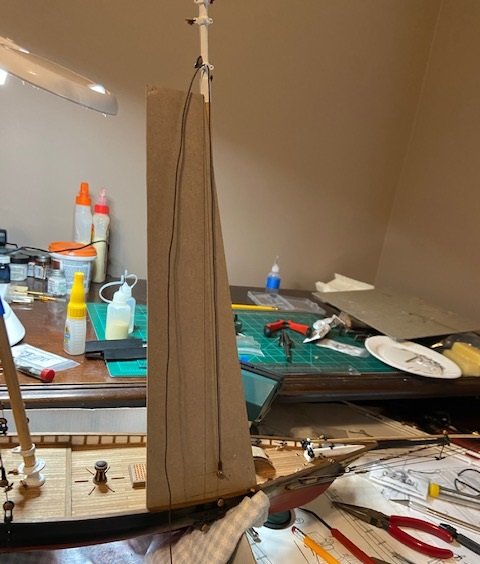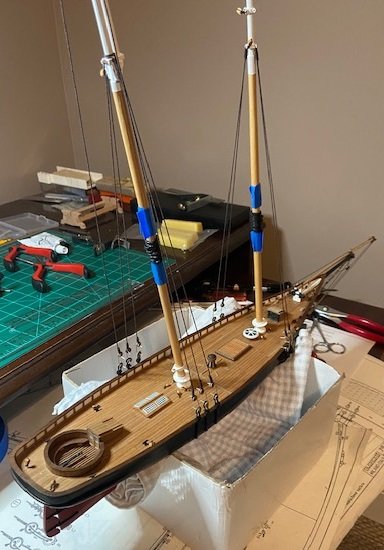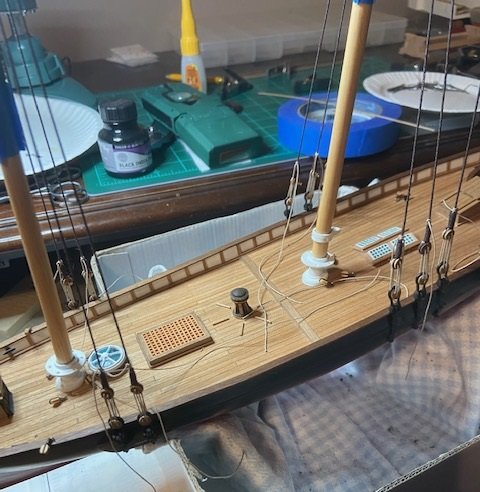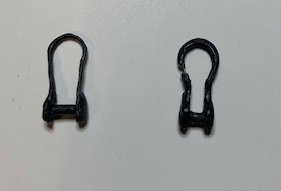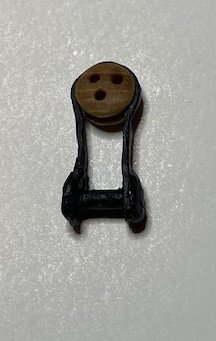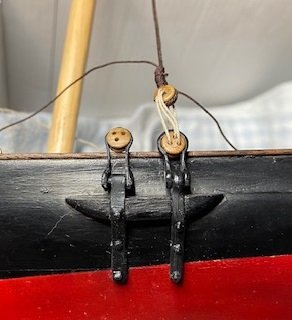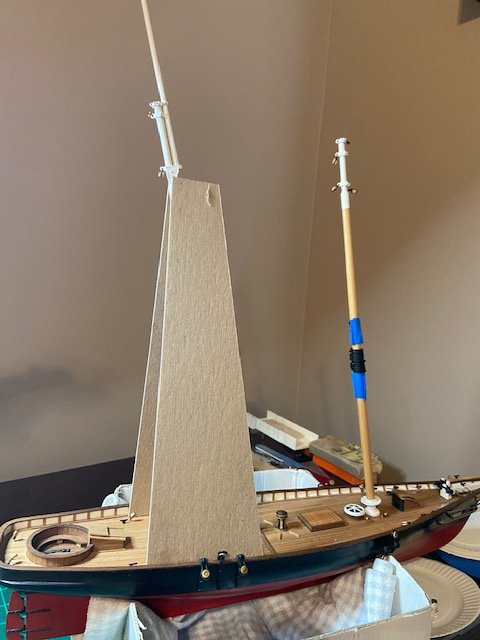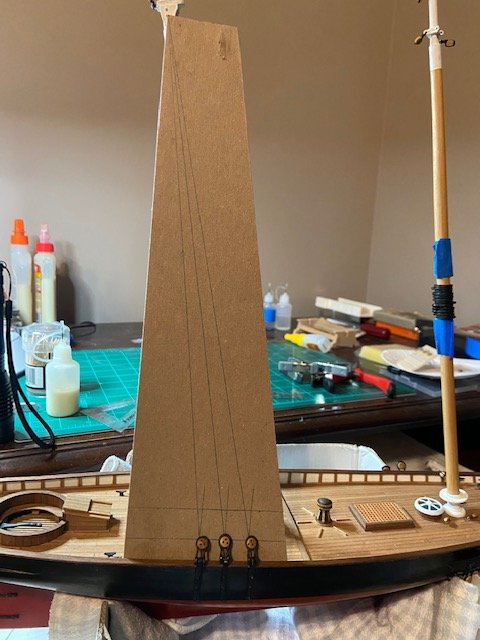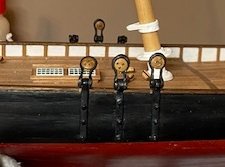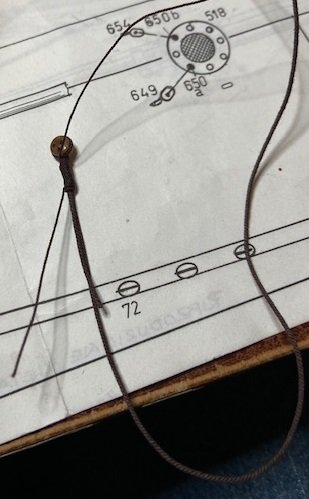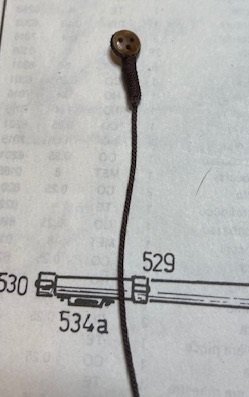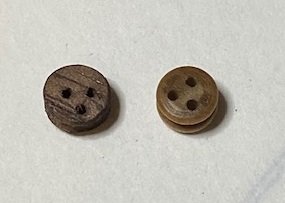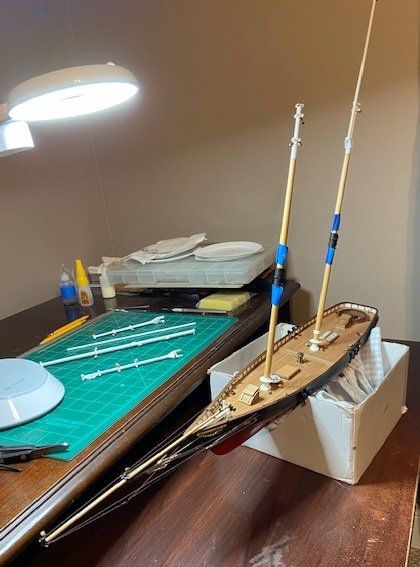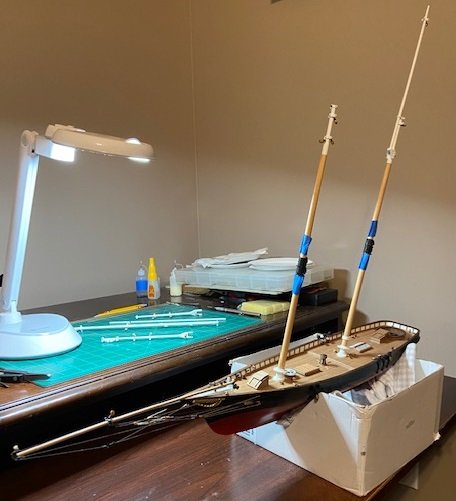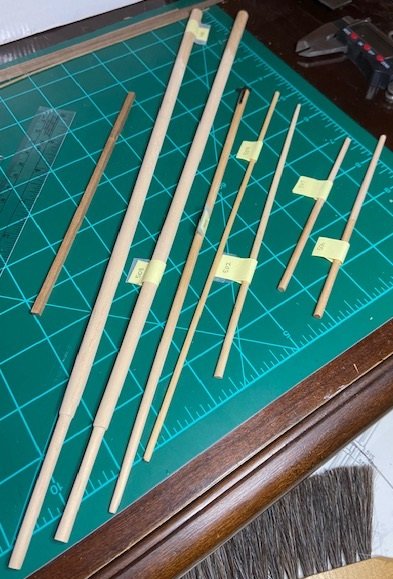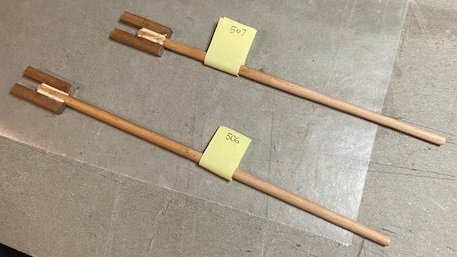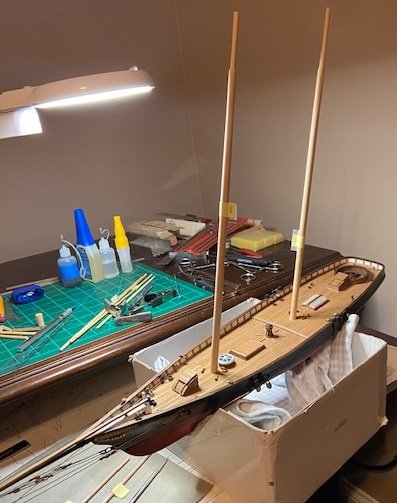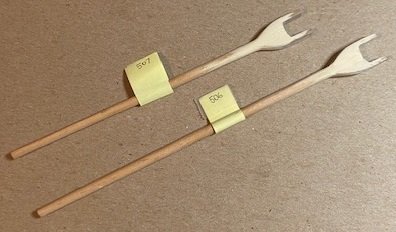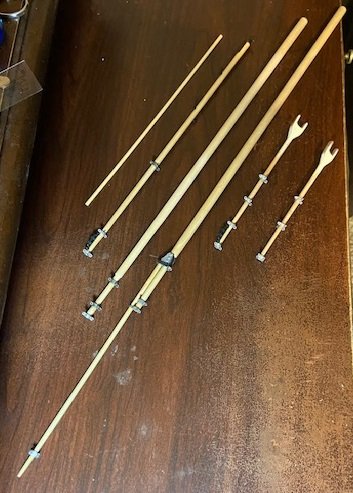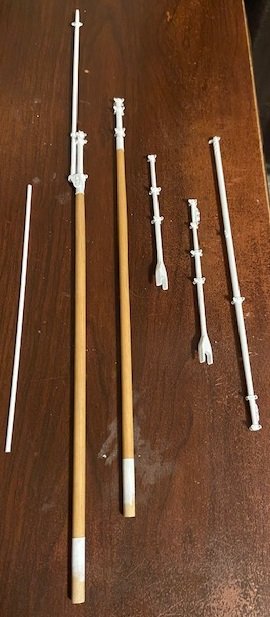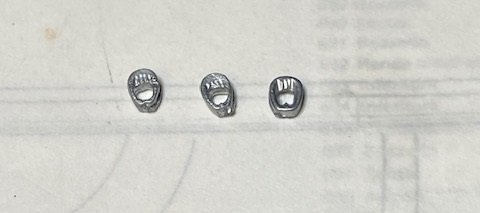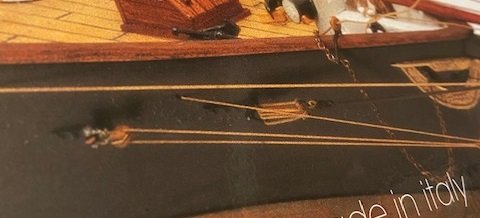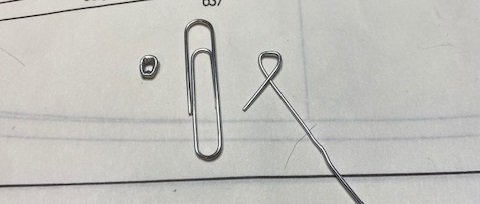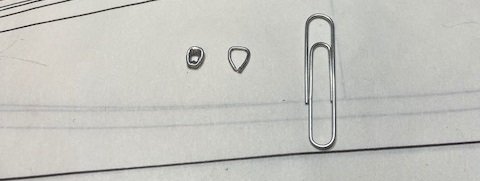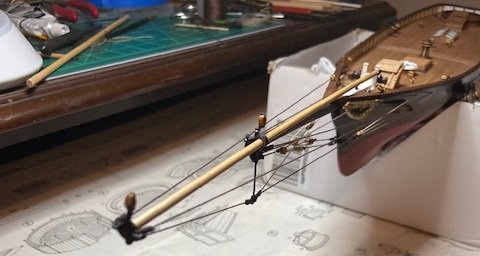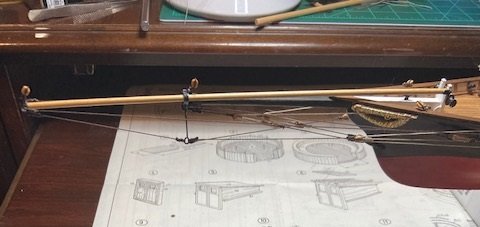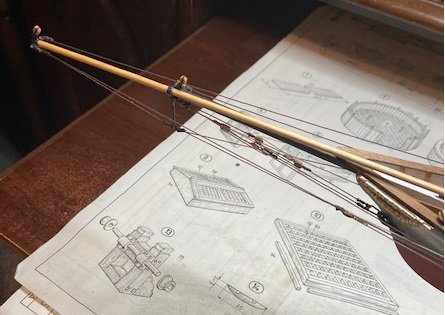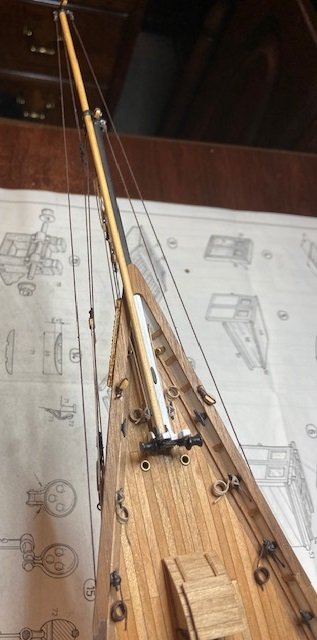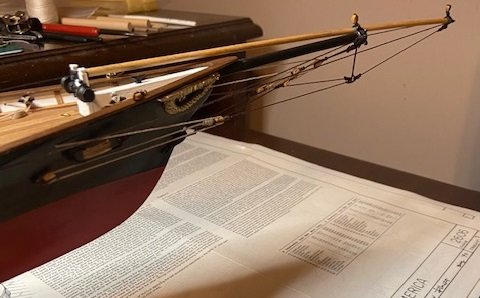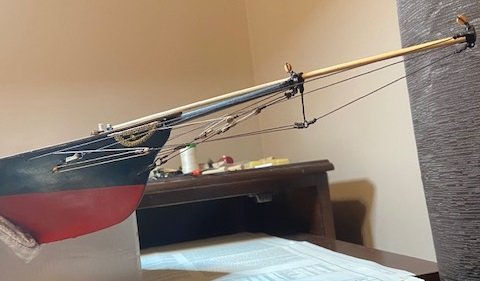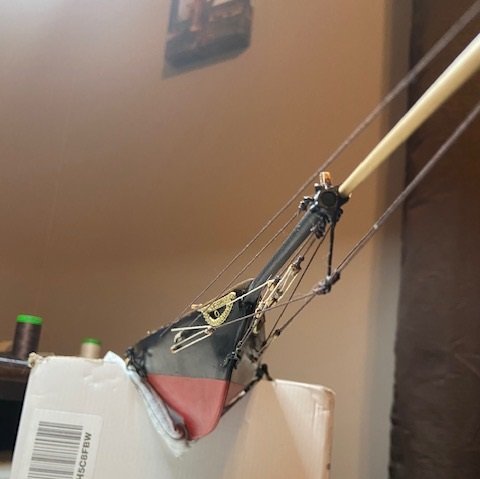
TUEL
Members-
Posts
55 -
Joined
-
Last visited
Content Type
Profiles
Forums
Gallery
Events
Everything posted by TUEL
-
Thanks Bradley! After cleaning up the loose rope and securing it to the various cleats, I mounted the boom to the staysail and installed the rope around the boom. Next, I rigged the staysail onto the mast and installed the rope to secure it to the main mast and the bowsprit. Next, I installed the brass rings on the upper part of the staysail. Here are some pictures with the rope completed around the staysail. Once the staysail was mounted, the last thing two things left were to paint the stand, and to make an American flag that was accurate to the 1851 timeframe of the ship (with 31 stars). The flag included with the kit was not acceptable. It a Betsy Ross flag (13 stars) from 1776 and does not look the least bit realistic. It’s hard to understand why Mamoli would not consult the history books and know this flag was not accurate. The flag included in the kit looks to be screen printed with high gloss cloth and ink and is only printed on one side. Very poor example. I began googling to try to find an accurate, properly sized flag that could be purchased, but just couldn’t find anything to suit me. From there I began researching methods to make my own flag and have found a method that I know I will use over many times going forward. I found the method I used in a post on Sept. 25, 2017 on the Model Ship World forum by member Chuck in his build log for the HM Cutter Cheerful. Another member commented on his flag and asked how he made it, and that is the method I used on mine. For context, I’ll repeat it here. The flag is made from the tissue paper you use to pack boxes or maybe a gift. Many people use this as filler in gift bags. Its white, and is very thin. My wife keeps boxes of gift paper and had some of this tissue paper so that is what I used. I made a PNG file of a flag I found on line that is the 1851, 31-star flag. I did a screen print and saved it to the clipboard, and then I used Microsoft Paint to resize it and clean up the edges. I determined the size I wanted through several test prints using an HP 7150 ink jet printer. I printed it on 24 lb paper so that it would be a little stiffer than normal. I determined the size I would use by measuring the flag provided in the kit and used those dimensions. After printing the flag to the size I wanted, I cut a piece of the tissue paper about ½ inch larger on the sides than the size of the flag, then taped the piece over the flag image on all four sides. I reinserted that sheet into the printer and reprinted the flag. I let it dry for a few minutes and trimmed the tissue paper very close to the edge of the flag, with no white space on the edge. The tissue paper is so thin that the ink will soak through to the other side but not entirely. I then immediately sprayed the reverse side with Krylon Matte Fixatif (which I had purchased at my local Hobby Lobby). Per the post by Chuck that I am referencing here, you should not be afraid to spray too much. This facilitates the ink soaking through to the back side further and it will look like it is literally printed on both sides. Then after it dries flip it over and spray the front side. Next you can shape it to suit, perhaps using various size dowels. You can also spray the fixatif more to really soak it because this makes it easier to shape...you can do this several times if need be. Once dry it holds its shape. Next, I placed some tape (I lapped the tape so that is was maybe 1mm x 2mm) just over the corner of the flag on both side to hopefully strengthen it a bit, then punched holes with a large hat pin to thread the halyard rope through. So, I now come to this point where I can now say that I am finished. Here is a picture from yesterday with the stand not painted. Here are some subsequent pictures from different angles after painting the stand. I’m thinking I’ll do one more post in a day or so and maybe list some observations and lessons learned. I’m glad to get to this point and looking forward to my next build. As soon as time permits, I will post pictures of the finished ship in the gallery. Thanks to everyone who followed my build log and commented.
-
I continued with rigging the repaired bow. I left some of the rigging below the bowsprit loose so that when I added the jib sail I could tighten them simultaneously with the rigging on the jib sail. Here is the jib sail completed with the rigging tightened down and secured. I’m now cleaning up the loose rope and will then mount the staysail.
-
It’s been a little over a month since I last posted. I took a hiatus from the build after my crack up I showed in my last post. I’ve posted in the past that we also plant a large vegetable garden and we’ve been picking and canning vegetables the past several weeks, so there really wasn’t much time to work on the ship. I’m back focused and have progressed on rebuilding the bow area. Here are a few pictures. I’ll re-rig the bow area over the next few days and then continue with mounting the sails.
-
Thanks md1400cs! I continued the rigging of the sails. Then, I had a significant setback. I turned my chair around and the armrest caught the edge of the ship, and off onto the floor it went, bow first. I haven’t worked on it for a over a week. One step forward, two steps backwards. I’ll start repairs in the next couple of days, but still pretty frustrated.
-
I ordered some additional .045 rope from Syren. I was selecting the rope I noticed they offered 0.20mm rope. I decided to include that in my order because I thought it would be a better choice for seizing the 0.45mm line I’ve been using. Once I received it was the correct size for the reefing lines. I proceeded to use it for the reefing lines on the mainsail, foresail and staysail. Here are the finished reefing lines on each of the 3 sails. Once that was complete, I began rigging the mainsail. Here are a couple of pics showing the progress. Here is the finished mainsail. In the process of working around the rigging and sails, two of the chain plates on the starboard side have come loose. Looking a little closer, it’s the same problem I’ve had before with the fatiguing of the white metal. I anticipated this and ordered some brass strips of various widths a few weeks back. I fashioned two replacements from the brass. It was so significantly easier to work with and I have now replaced the two failed chain plates. Now I will turn my attention back to sail rigging.
-
I’ve been purchasing all of my rope from Syren. Not knowing how to estimate it, I’ve had to order more 3 different times. It’s a bit expensive so I was trying to optimize it with each order, and I probably spent too much on shipping trying to do that. I’m using tan and brown rope, mostly 0.45mm diameter. As I began seizing around the blocks, I used some thread that I found at Hobby Lobby for the seizing. That thread matched somewhat, but it had a bit of a gloss to it and it just didn’t match well enough to suit me. The 0.45mm rope is made from 3 threads twisted together. I realized that I could untwist the rope and separate the 3 threads, then use that thread for seizing. It appears to be an optimum size, and the color matched perfectly to the rope you are seizing. Here are a few pictures of the first step of untwisting the rope. Once it is separated, it still has a twist in it as you can see in this picture. I found that if I would pull the thread through bee’s wax several times it begins to take the twist out until it is relatively straight. The down side I found is that it loads the thread up with wax, which in turn makes it somewhat sticky. That makes it a little harder to work with, but the results are still good. I began the process of stitching the rope to the edge of the sails. I used 0.88mm rope for the edges of the sails. As I worked through this, I separated the 0.45mm rope into threads, pulled it through the was until straight, and just sequenced through the stitching in that manner. Here are the sails with the 0.88mm rope attached to the edges.
-
I made an extra copy of the sail patterns when I made the original copy, so I was able to use those to overlay the sails. This allowed me to determine how I would handle edge, and also to locate the position of each eyelet. I decided that I would try to make a finished edge on the sails. To do this I would need to allow enough extra around the edge of each sail to allow it to overlap twice. The drawings show a 3mm edge, so I cut the edges 6mm from the edge of each sail. My wife helped me a great deal with the sails and after we worked with a couple of the sails, we realized that 6mm wasn’t enough, but by then the cuts had been made (measure twice, cut once sure applies here). I used a product named Stitch Witchery. This is a bonding web for fabric and can be purchased in various widths. It is a polyamide fusible bonding web material that is heat activated. We cut it to the correct width, placed it between the fold of the sail fabric, placed a damp cloth over it and ironed it. I think it is much superior to trying to glue the fabric because it allows you to have just enough bonding material to bond the fabric, with no permeating into the cloth. Here is one of the sails completed. I wasn’t really satisfied with it. I believe we cut the edge too tight, and consequently it was very difficult to keep it straight. Also, the bonding material appeared to shrink and pull it in in some places. This experience to file away and use on the next build. Here are all of the completed sails. I turned my attention to the eyelets. The issue with this kit is that the eyelets are very tiny (~1-1.5mm). I think I need a 1mm tool to set them, but if that tool exists, I can’t find one. As a compromise, I purchased a 1.5mm tool. This tool has to be inserted into the eyelet and hammered. My preference would have been to find a plier type setting tool, but I wasn’t able to find one for this size of eyelet. The setting of these eyelets was not a good experience for me and I was not pleased with the quality of my work. I spent some time trying to find information as to the procedure for setting the eyelets. I was not able to find a great deal of information on MSW. There are plenty of comments about eyelets and pictures, but practically nothing on setting them. I did numerous Googles just trying to find some guidance but didn’t find much. I used the extra patterns to overlay the sails and mark the location of the eyelets on each sail. I didn’t make any pictures of that process, but I started by make a pin hole in the center of each eyelet location. Next, I used a sharp pencil to mark the cloth with a dot beneath each pin hole location. I have a soldering aid tool that has a chisel on one end and an offset awl on the other. I found I could place the sail over some hard cardboard, and use the awl end to punch a hole at the eyelet location. I would set the eyelet in the hole, turn it over and then use the eyelet tool to hammer the end. The I would use a small hammer to flatten it the rest of the way. I had a lot of issues due to the setting tool being a 1.5mm size, and some of the eyelets did not collapse evenly. Once that happened, I had to remove the damaged eyelet and set another one, sometime damaging the cloth around the hole. The kit came with 138 eyelets, and the sails required 115. When finished I had 3 eyelets left over. My next step is to attached the rope around the edge of each sail.
-
My approach to the sails was to make a copy of each sail to use as a pattern to mark and cut the cloth, and for the location of seams and eyelets. My first step was to make a copy of the sheet with the sails printed on it. My first attempt was to use my laser printer to make the copy of each sail, however it would only print 8.5”x11”, and most of the sails would not fit on one sheet. I probably could have used 8.5”x14”, but I would still have to piece each sail copy together. I copied portions of each sail with the intention of taping the pieces together to make the full sail pattern. My seamstress wife advised me that it would be much better to have each sail pattern on one sheet not pieced together. I took the plan sheet to a local copy/shipping store and had them to make two copies of the sheet, then cut away the portion with the sail patterns on one of those copies. Next, I cut each individual sail from the sheet. I continued to look at the build logs of Hamilton, Greatgalleons and Flyer. Hamilton provided very few pictures and limited comments in regard to the sails. The other two have more detail, and that was helpful. One of the build logs showed the edge of each sail being folded over once, but being left unfinished. The other log showed the edge being cut, folded over and glued, also unfinished. I showed these to my seamstress wife, and her recommendation was to fold each edge over twice and stitch it so that it has a finished edge. Looking at the patterns in the pictures above, you notice that some of the edges are not even. This was due to the position on the plan. Looking at the edge of each sail, it shows a 3mm overlap. To fold it over twice I needed 6mm on each edge to allow for two 3mm folds. I cut pieces of paper and taped to each edge where necessary, then cut each sail to have 6mm from the edge of the sail. Here is the result of each sail pattern, with the 6mm edge. Next, we pinned each sail to the cloth included in the kit. I needed help and advice, but this is not what I had in mind. Here are the sails pinned to the cloth and cut, allowing for the 6mm edge. I had planned to attempt sewing the seams and edges, but my wife wants to do it so she has a contribution to the ship. She has a Husqvarna sewing machine with a lot of features and adjustments. After a couple of test seams, we decided a stitch length setting of 1 had the best appearance. My approach is to use the paper pattern pinned to the cloth as a guide for the seam locations. Here is the reverse side of the seam. This is the completed sail. We realized through the testing that the sewing machine needle perforates the paper, so it should be easily removed. This is the reverse side from the paper. As you can see here, the sections of the paper are easily removed because of the perforation in the paper made by the needle. That’s it for this post.
-
Phil, Thanks. It's definitely been a good learning experience. I really expected a learning curve here so my frustrations are limited. I'll definitely know what things I need to do better on the next build. I'm sure that will be another learning experience too. I voice frustrations, but I've really enjoyed building this kit. Tim
-
I have completely replaced the rigging underneath the bow. Some of the rigging came lose or was knocked lose as I was repairing the bowsprit. I wasn’t pleased with the seizing on most of the rigging in this area so I opted to replace it. Here are a few pictures of the re-rigging. I completed the rigging around the spanker boom and stern area after completing the bow. Here a few pictures of this stage made with a little better lighting. I next attached the two gaffs and finished the rigging on those as you can see in these pictures. It doesn't seem like a lot of progress since my last post, but it was time consuming to me. I am now turning my attention to the sails. I am fortunately married to an excellent seamstress, so I will rely heavily on her guidance (as I always do) and her first class high dollar sewing machine.
-
I had an issue with the bowsprit as I added rigging on the masts. When I first began the rigging around the bowsprit and the bow, the bowsprit broke loose from the deck due to the torque I was placing on it while tightening the rigging rope. This happened at least twice, maybe 3 times. At that time, I felt I did not have enough surface contact to get it securely glued, and I added a strip under the bowsprit and used epoxy rather than wood glue. When I added the rigging rope to the mast and down to the bowsprit, the torque placed on it once I tightened it up pulled the bowsprit loose again. My thinking was that I had made a rookie mistake of not anchoring the bowsprit or not having an adequate glue surface to hold the tension. One thing I’ve realized through the rigging process is to consider the rigging anchor points and reinforce those points. Also, I realize I do not know how much tension to apply to the rigging ropes, and how does that impact the model long term. My tendency was to put as much tension on each rope as was reasonably possible, and now I’ve realized that was probably not necessary and was too much. On future models, I expect I will make my own metal parts given the poor quality and the softness of the white metal parts I’ve seen with this kit. Other kit manufacturers may have higher quality metal parts so that may not always be necessary. When I saw that the bowsprit had separated from the hull and was pulling up on the railing, I loosened the rope to the mast. This photo shows how railing has separated. The separation was significantly more before I loosened the tension on the upper rigging rope. One thing that came to mind was that I could countersink a small wood screw into the bowsprit and down into the hull and keel, and I felt this would sufficiently anchor it. I made a trip over to my local Lowes and then to Home Depot looking for the smallest wood screw I could find but was sufficiently long enough. The smallest screw I could find was a ¾” size 4, which is a little smaller than 3mm and about 20mm long. I ground the head of it to be about 4mm and the bowsprit is 5mm. I staged drilling the hole until I had it to a suitable diameter and depth, then installed the screw. Without considering the stress I was applying to the bowsprit due to the wood that had been removed, the bowsprit fractured. I realized that I needed to place a filler strip between the bowsprit and the deck to keep it supported. This photo shows the screw installed. I covered the screw with several coats of wood filler, sanding each coat. Once it was adequately covered I painted it what as you see in this photo. I re-glued the railing and this photo shows the result. In handling the pieces as I made this repair, some of the rigging beneath the bow was bumped loose. As I’ve looked at it, I was not satisfied with the job I did with the seizing in this area, so I have decided to next replace some or possibly all of that rigging.
-
It’s been about 2 weeks since my last post, and it’s been a frustrating 2 weeks as I’ve worked on the shrouds. This kit has 10 shrouds, 4 on the forward mast and 6 on the aft mast. My rigging seemed to go well, and I was able to get all shrouds installed, but not without issues. This sequence of photos shows the progression. My biggest concern as I approached it was to get the rope to the correct length so that each would have adequate tension. I’ve tried to follow the plans for the correct length and the correct position of the deadeyes, and it seemed to me that each needed to have as much tension as each component could support. I realize now that this is not correct and I placed too much tension on the shrouds, and as I worked from one to the other the chain plates were being stressed. The white metal is soft of course, and eventually the tension would pull various deadeyes loose from the chain plates. After this happened several times, the chain plate metal fatigued and wouldn’t hold the deadeye, and eventually broke. I had to remake 2 more of the chain plates. Also, another metal piece that failed was one of the brackets around a deadeye. This was another piece that I had to remake as well, and all of this remake work was time consuming. This photo is the replacement deadeye bracket and chain plate. It’s not an exact match, but for the sake of time and in wanting to move forward with my build I think I will live with the way it looks. I also realized that I had made the shrouds for the front mast too short to try make have more tension, and that of course it what caused the chain plate metal to fail. I decided to remove the front mast shroud rope and replace it with rope that had a more appropriate length, and would still have the appearance of tension without stressing the other pieces. I hope to have finished the shrouds by next post. It seems every corner I turn there’s new lessons to learn.
-
GrandpaPhil, very good advise to use a dowel rod. That did not occur to me. I'll file that away for future reference. Thanks!
-
I have made previous comments about the poor quality of the Mamoli kit. That includes poor quality of the wood and poor workmanship of the white metal pieces, but probably more frustrating is that the kit did not include enough of several of the different pieces. It seems to me it would behoove a company to add a few dollars to the cost of the kit, and then supply a few extra pieces. It would be better to have customers that appreciates extra pieces versus a customer being disgusted with the kit, like me, but it’s a moot point given that Mamoli is now out of business. I have learned a good lesson here – do a good thorough inventory of the kit components to begin with so that you know what needs to be acquired or made… before you need that particular piece. The kit required 20 deadeyes, and no, I did not count how many I had until I needed them here for the rigging. The kit only included 19. I considered a month or two ago buying other deadeyes from Syren because of quality, and now in hindsight I wish that I had. Looking at those supplied with the kit, my original thinking was that I could live with the quality of them, but I failed to count how many I needed versus how many I had. I only need one more which would cost very little, but also cost $10-15 to ship. That’s not acceptable. Therefore, I found some scrap walnut pieces and laminated them to get the right thickness, then cut and sanded that to the shape needed for the deadeye. It’s somewhat darker in color, but at this point I think I’m willing to live with it. Here is the result compared to one of the original deadeyes. In reading many references and other build logs, I decided I would rig the shrouds using wire bent to the proper length to insert into the deadeyes. As I attempted to do that, I found it difficult to maintain the correct length while tying the ends. I decided to abandon that method and use stiff cardboard as a back plane to the shrouds. I cut two pieces as you can see in this photo. I marked the position of the 3 deadeyes on each side closer to the aft end of the ship, then used those markings to make alignment marks up to the upper part of the mast as you see in this photo. In the process of doing all of this work, the bracket that holds the middle deadeye that you see in this picture fit adequately into the chainplate, however the end of the chainplate forming the hook for the bracket was shorter than the others. As I worked through this, it fell off many times. Each time I would reinsert it, and several times I tried to bend the end further so that it would stop falling off. I repeated this until the metal became fatigued, and it eventually broke. I did not have any material to refashion a replacement piece, and I did not want to wait to order a replacement which in turn would likely not match the original chainplates in appearance. I began searching in my shop supplies and eventually found a small bracket that was the same thickness as the original chainplate, but also somewhat pliable. From that I fashioned a replacement piece as you can see in this photo (I did not make any other photos of the piece as I was working on it). The middle chainplate is the replacement. I drilled holes at the positions where the simulated bolts are located. I mis-measured the position of the top most hole, so its slightly off in comparison to the other chainplates. But it was actually a good exercise and I learned a little bit from it. I used the white metal chainplate that was broken to fashion some pegs for the holes, then used epoxy to glue them. It gave the new chainplate a very similar appearance to the others. Bottom line is its good enough to live with and to learn from. I have turned my attention back to the rigging and have begun tying the deadeyes. Here are a couple of photos of the first one. Next post I’ll continue from this point with shrouds on the ship.
-
I had to taper back my build time during the past month or so due to some other demands, but have now refocused and made a little progress. After painting the masts and boom pieces, and gluing some of them together, I tied the required blocks to each piece. I thought it would be easier than tying them once the masts were mounted and glued. Here are the booms and masts ready for mounting. I really appreciate Bob’s comment on 02/09 regarding the rigging being a slow process. This is my first kit and I’m struggling with the rigging, and going very slow. I’ve found a lot of helpful information including several good YouTube videos. I think rigging is just a matter of practice and repetition, of which I need a lot. Hopefully I can train my fingers to be better coordinated as time goes on. I think it’s just a matter of working through some kit builds and continuing to research. Also, I’ve found some great information here on MSW. Once I finished this step I glued and mounted the masts as you can see here. Next up, I’ll continue rigging with the shrouds.
-
Thanks Bob! This being my first build I can only really comment about the Mamoli kit. There were a couple of other Mamoli kits I had on my punch list to build later, but after this one I will not purchase another Mamoli kit. I've made numerous comments about quality, none of which have been positive. It's not just the metal parts I've commented on recently, the whole kit is that way. Some of the wood is of adequate quality, some was not. Another example is the poor workmanship on the bulkheads even though they are laser cut (don't match the drawings). Maybe a more experienced builder may have noticed some things and made corrections, but I didn't have that experience to fall back on. Also, the English translation on the drawings is poor and not thorough enough. The documentation is limited to the limited information on the drawings. I have to believe the Constructo kit is a higher quality kit. I actually was going to buy it or the Mamoli kit, and chose the Mamoi kit because it include a jib boom and sail, which I thought really added to the look of the model. The America had a jib boom originally, but it was lost in heavy seas when they crossed the Atlantic with it, so actually both kits are historically accurate. I suppose I could have added the jib boom and sail to the Constructo kit, but was more concerned with having a kit that included everything and had limited scratch build additions. I wouldn't recommend the Mamoli kit. Tim
-
Thanks Richard! Yes, I realize I should be making my own metal pieces and will on future builds. With this first build, I thought I should stick with using what came in the kit rather than going through a learning curve on that too. There are several Mamoli Yacht America build logs that I have been to often, one of which was built be Greatgalleons about 2 years ago. He made most of his metal pieces, all of which were very well done. I've blamed this problem more on poor quality by Mamoli. I sure hope other kit manufacturers are better. Tim
-
I have cut the masts to size and have now sanded all of the round stop per the drawings. Using 4x4 mm walnut strips, I cut and glued the extensions on each of the gaffs. The deck holes where each mast will be mounted were 0.5 to 1 mm too small. I filed each out to fit the appropriate mast. Here is a dry fit. I sanded each gaff, then used wood filler to form a more rounded end at the base of each one. I began test fitting the collars and other hardware, sanding each to get the fit that was needed. I’ve stated numerous times that I am very disappointed in the quality of the parts and pieces included in the kit. The metal pieces are no exception to that. Each one required some filing and some touch up, but some of them were almost unacceptable. The pieces for the cap assembly (part 510) used to mount the top part (part 502) to the main part of the aft mast (part 501) did not fit well at all. The side pieces did not line up flush with the edges of the cap piece once they were mounted to the mast. I tried trimming the mast to achieve a better fit, but was not able to get a satisfactory fit. I tried using epoxy to try to fill in the gaps but wasn’t satisfied with that and removed it. After some additional filing and sanding I decided I had spent enough time on it and accepted as is. My point of this discussion is that it is a matter of poor quality from Mamoli (once again). They have the dimensions and molded the pieces, and their quality to pathetic in my opinion. Next, I painted the round pieces as seen below. The main masts were finished with several coats of tung oil in the area left natural. The next step is to rig some of the blocks to these pieces. It seems it would be easier to do that as single piece rather than installing the masts and doing it once it’s on the ship.
-
With the bowsprit and jig boom installed, I focused on the rigging around the bow of the ship. I spent some time looking at the other Yacht America build logs. I noticed rope color selection for each one and considered what approach I would use. I decided I would use dark brown for the rigging anchored to the boat, and light tan for the running rigging. I think I remember reading that somewhere. I may not be using the correct terminology here, but it will be obvious what colors I used in the subsequent pictures. I’m using rope from Syren. I agree with some of the other guys who have posted that the rope included in the Mamoli kit is just so poor. I mentioned several times that this is my first ship build, so this is my first pass at rigging of course. I’m finding myself staring at the boat trying to decide what to do. I looked at the hardware that I would need around this area, and there are 4 closed hearts indicated on the plans that are used near the bow, 2 on each side. When I inventoried these parts, I found that my kit only had 3 of them, not 4. Here are the closed hearts I’m referring to: I spent some time at various websites to see if I could find suitable replacements. I also went back to the other build logs by Hamilton, Mojofilter, Greatgalleons, and Flyer and looked closely at their pictures to try to determine what I would do. Finally, it occurred to look at the front picture on the kit box to see what they looked like there. Here is a picture of it (zoomed in): The closed hearts in this picture are very different from what was supplied in the kit, and it occurred to me that I should be able to make these. After looking at all of my supply of wire, I decided a common paper clip would work well because the wire has some stiffness but yet is also pliable. I proceeded to fashion 4 of these closed hearts from paper clips. After fashioning the hearts, I soldered the ends closed. Once installed, I painted these black. Having found a solution to that issue, I began rigging around the bowsprit and jig boom and have completed that work. Here are several pictures of the completed work: One thing that can be noticed in these pictures is that I have a slight bow in the jig boom. I didn't notice this until after much of it was installed and didn't want to re-do it. I suppose that when I applied tension through the blocks and tied them down is caused the bow. It's something I've filed away for future boat builds, and I think I'll just live with it. I noticed one or two other boats that had a similar bow, so it's easy to do if you haven't dealt with it before. I need to install one cleat on top of the jig boom near the winch, and then I’m ready to begin work on the masts and the upper rigging. I'm slow, but I'm getting there.
-
As I’ve worked on tying the blocks, I’ve improved somewhat. I realize now that this just takes practice so I’m moving forward rather than trying to perfect it. I have prepared all of the blocks that will be mounted to the deck and railing. Here are several pictures of the blocks after I’ve installed and glued them. After installing the blocks, I began work on the bowsprit. I trimmed the tapered portion of the bowsprit with an Xacto knife, then sanded it to round form from a length of 70 mm out to the end of it. I tapped it and painted the outside portion black. Next, I re-taped it and painted the inside portion white. Here is the completed bowsprit. Here is the bowsprit installed. Next, I installed the jig boom. Here are several pictures of the result.
-
I mentioned in a previous post that the rigging seems to be the most difficult part of the build for me. I suppose that is due to my lack of expertise and experience. I’ve made my first attempts at tying rope to the blocks and eyelets, and just realize this will take some time to gain the expertise. I have read many MSP posts could regarding blocks and hooks. In one of the posts, the writer listed links to a couple of YouTube videos, one of which I thought was very instructive. The title is “Seizing a rope or line on model ships”, by J Brent. Here is the link: https://www.youtube.com/watch?v=nzDl5MYOgmQ Mr. Brent’s method seemed to me to be the best approach and I tried it on 2 blocks. My first effort was very sloppy and loose, but I improved on the second one so I realize this is just going to take practice. On the second block I used some thinned PVA glue (read that in one of the posts) to try to better secure it. I read numerous comments (pro and con) about using CA glue, and thought the PVA glue would be better. I still felt the rope was not tight enough, likely due to the knots I tied. Here are the two attempts. The first one is at the top (untrimmed) and the second at the bottom. The second one looks okay, but it is actually too loose. In another post, I found a link to another YouTube video by Mr. Brent titled “Rigging a block to a mast or spar for model ship builders.” Here is the link for that video. https://www.youtube.com/watch?v=WUrRb66VSSE&t=2s This video is much more applicable to the certain rigging I’ve started with. In this video he refers to a post by an MSP member named Bender. I was able to find the post in MSP and here is the link to it. https://modelshipworld.com/topic/1056-tying-blocks-to-yards-or-masts/?tab=comments#comment-133709 Bender’s work is exceptional in my opinion and this will be very useful. I used it on the 3rd block and think this is a much better method. Bender’s post is titled “Tying blocks to yards or masts.” The method here worked well for me because I am tying to an eyelet with a loop at one end of the block, and the method worked just as well as if I were tying to a larger diameter mast. Also, in this application, you prepare both ends of the rope before actually placing them on the block, then the rope slips tightly on the block. Once I applied some CA glue, I felt like it was the result I needed. Using a hemostat to secure it, I started with the rope in an S-shaped pattern, with one loop of the “S” threaded through the eyelet as you see here. Next, I seized it with a smaller diameter brown thread use Mr. Brent’s method with the sizing. I removed it from the hemostat and here is the result. I placed the block in the loop opposite to the eyelet, tightened it down and added a drop of CS glue. I believe I used too much CA glue and will adjust that as I practice more. Here is the result. I’m still not very satisfied with the quality, but improving. Hopefully in my next post I’ll be done with these blocks. This is a slow go for me as I’m just not sure of what I’m doing, and I’m having to learn how to hold and manage the rope and thread as I go. Until next time...
-
Due to a lot of time constraints over the summer and into the fall I have not worked much on my ship build. I've done a few things that I will document here. Now that I have my attention on the rigging, I find that I’ve kind of stalled in that this seems to me to be the more difficult part of the build. I’ve spent some time through the summer months doing a few things, but also trying to read as much as I could about rigging. This picture show some of the cleats that I’ve installed on the deck. Per the kit instructions, I cut the channel pieces from 5mm x 5mm walnut. I continued to shape them and then cut the slots for the dead-eye chain plates. Here are the finished channels ready to be glued to the hull. I glued both channels and painted each. Next, I painted and assembled the chain plates and dead eyes. I wasn’t very happy with the quality of the dead-eyes included in the kit, but decided I would use them anyway. Here are the assembled chain plates ready to be installed. Here are the installed chain plates and dead-eyes. My next thought was to begin installing some of the blocks. I believe I should install the blocks attached to the deck before working on the masts. I have ordered and received Syren blocks which was my first choice, however, I noticed that the block looked different from those portrayed in the plans. I ordered additional blocks from Modelers Central since those seem to be more like the design and intention for the model. Once received, I was not satisfied with the quality, so it’s back to plan A and the Syren blocks. The quality of these blocks is certainly impressive, and it will not take away from the appearance of the kit. I was just simply trying to stay true to the model as depicted in the plans The block I’m focused on will be tied to eyelets. The eyelets supplied with the model are high gloss, brass colored. That seems to me to be out of place. I would think that much of the metal exposed to sea water would not appear as polished as these are. It occurred to me that a good source for eyelets are fish hooks, so I made a trip over to our local Walmart and purchased some Eagle Claw Cricket fish hooks, size 8. I clipped the hook end off of one as you can see in this picture. I think the color and finish seems much more applicable and appropriate to the kit. I’ve applied one coat of tung oil to the blocks. I considered purchasing a fly tying vise to use during the process of tying the rope to the blocks, but I have another idea that I think will work well. I picked one of the blocks with tweezers then mounted that in my vise as you see in this picture. Now I’m out of excuses and have to start tying the rigging rope. Hopefully my next post shows some progress.
-
With warm weather here in the south, a lot of activities have taken away from my build time. I have worked on the forward companion way the past couple of days and finished it. Here is a sequence of photos showing the build and some views of it mounted on the deck. I'm now ready to begin focusing on the masts, rigging and sails. As with everything so far, this is new territory for me. It will likely slow my progress some more as I will have to read reference material and study the other build logs I'm constantly going to - Hamilton, Greatgalleons, Flyer and Mojofilter.
About us
Modelshipworld - Advancing Ship Modeling through Research
SSL Secured
Your security is important for us so this Website is SSL-Secured
NRG Mailing Address
Nautical Research Guild
237 South Lincoln Street
Westmont IL, 60559-1917
Model Ship World ® and the MSW logo are Registered Trademarks, and belong to the Nautical Research Guild (United States Patent and Trademark Office: No. 6,929,264 & No. 6,929,274, registered Dec. 20, 2022)
Helpful Links
About the NRG
If you enjoy building ship models that are historically accurate as well as beautiful, then The Nautical Research Guild (NRG) is just right for you.
The Guild is a non-profit educational organization whose mission is to “Advance Ship Modeling Through Research”. We provide support to our members in their efforts to raise the quality of their model ships.
The Nautical Research Guild has published our world-renowned quarterly magazine, The Nautical Research Journal, since 1955. The pages of the Journal are full of articles by accomplished ship modelers who show you how they create those exquisite details on their models, and by maritime historians who show you the correct details to build. The Journal is available in both print and digital editions. Go to the NRG web site (www.thenrg.org) to download a complimentary digital copy of the Journal. The NRG also publishes plan sets, books and compilations of back issues of the Journal and the former Ships in Scale and Model Ship Builder magazines.

